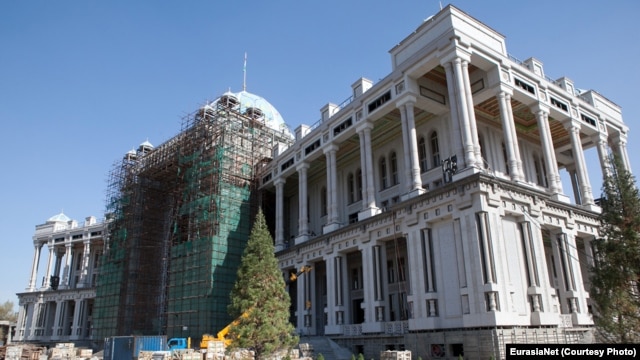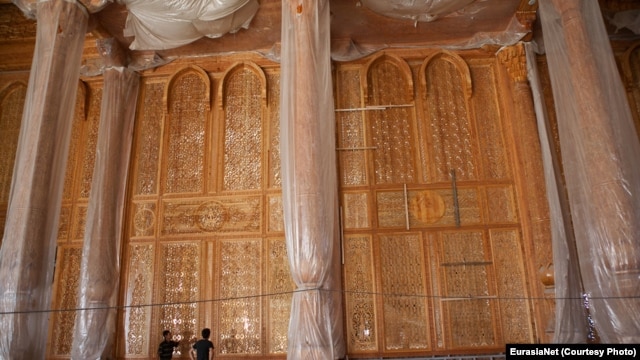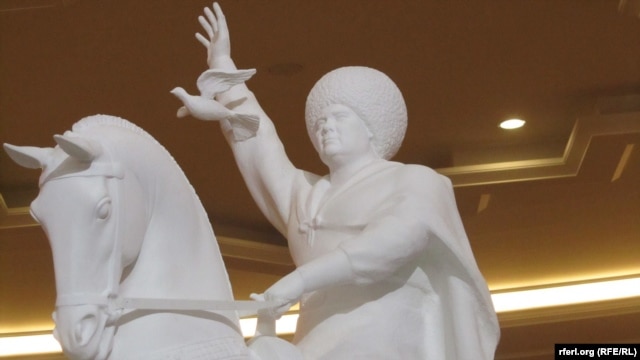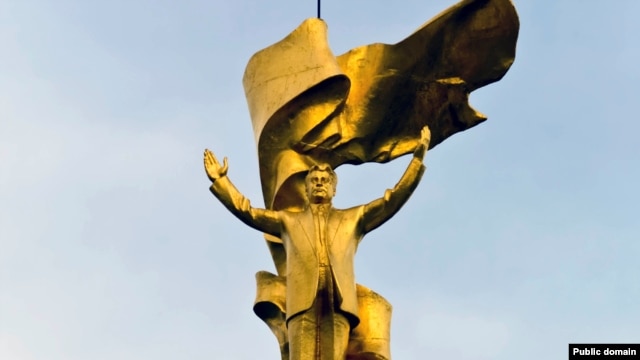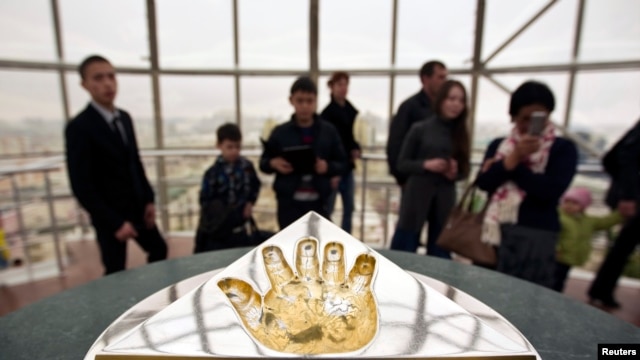-
- July 23, 2018 - 2:51 pm
- Bulgaria
- Comments Off on A New Future for Buzludzha

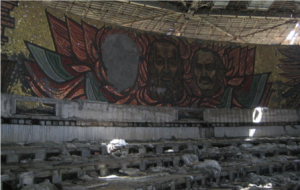

by Isabel Post
ARIA Undergraduate Researcher, McGill University
A crumbling communist monument in eastern Bulgaria faces a new hope of restoration. According to a report by the Calvert Journal, Bulgaria’s “Buzludzha” monument recently opened its doors to a group of reporters for the first time since its abandonment after the fall of the Bulgarian communist regime. This development is a major breakthrough for an ongoing grassroots movement to restore the monument as a museum and tourist attraction.
Construction on the “House-monument of the Bulgarian Communist Party” began in 1974 and was finished by 1981. Buzludzha mountain was chosen as the site in order to commemorate an 1891 secret convention of Bulgarian socialists that resulted in the formation of the Bulgarian Social Democratic Party, a forerunner to the Bulgarian Communist Party. The construction of the monument was a massive undertaking, funded primarily by stamps sold to the Bulgarian people. Over 70,000 tons of concrete and 35,000 tons of cobalt glass were used to complete the structure and the mosaics inside, and the total cost of the project was more than 25,000 lev (about 35 million USD today). The investment had a short return-- the monument was open to the public for only eight years before it was abandoned in 1989, when the Bulgarian communist regime fell from power. It has since fallen into serious disrepair as a result of neglect and vandalism.
Despite being officially closed, the site has maintained limited popularity in recent years as a tourist attraction (for those who dare to find their own way in) and as the backdrop for a few music videos, thanks to its aesthetic and historical appeal. Massive and striking, Buzludzha dominates the mountainous landscape. Inside, the walls are covered with mosaics depicting famous figures in the history of Bulgarian communism.
For the past few years, a conservation effort known as The Buzludzha Project has appealed to international conservation groups for funding to repair, renovate, and re-open Buzludzha. The long-term goal of the project is not only to preserve the monument, but to transform the monument’s content to fit within a modern cultural context. The content of the monument, which in its present state celebrates Bulgarian communism, will be upgraded with “new museum elements” in order to present a “full and comprehensive account of Bulgarian history.” The end result, according to the project’s website, would be an educational complex that positions Bulgaria’s communist past within the entire framework of the country’s history since antiquity.
A major breakthrough for the project came in March, when conservation group Europa Nostra named Buzludzha as one of Europe’s seven most endangered cultural heritage sites. Most recently, the monument was opened officially for the first time since its closure, when reporters were allowed inside to photograph the decaying interior. According to the Calvert Journal, this is in anticipation of a visit later this year from European and Bulgarian experts who will assess the structural integrity of the monument, “with the view of opening it officially to tourists.”
Before the announcement in March of Buzludzha’s classification as an endangered site and the resulting snowball of administrative progress, the future of the site was hardly certain. In November of 2016, Bulgarian lawmakers voted to outlaw the public display of communist symbols. This was a blow for the Buzluzhda Project’s organizers, who feared the law might preclude Buzludzha monument from re-entry into state-sanctioned commemoration. It remains uncertain how this law and the iconography of the site will reconcile. Perhaps the monument will experience the same fate as the Heineken logo in Hungary, where a similar ban on communist iconography threatened display of the logo thanks to its red five-pointed star, but ultimately did not lead to enforced censorship. In any case, while restoration presents significant obstacles-- both physical and bureaucratic-- a reconstructed and repurposed Buzludzha will allow Bulgaria to benefit from a cultural asset almost lost to time.
Sources:
Davies, Katie. "Bulgaria's Buzludzha Monument Opens Its Doors for the First Time in 8 Years." The Calvert Journal. May 18, 2018. Accessed May 25, 2018. http://www.calvertjournal.com/news/show/10037/bulgarias-buzludzha-monument-doors-open-tourists-survey.
http://www.calvertjournal.com/news/show/10037/bulgarias-buzludzha-monument-doors-open-tourists-survey
Lee, Nathaniel. "Take a Look inside an Abandoned $35M Communist Monument." Business Insider. December 12, 2017. Accessed May 25, 2018. http://www.businessinsider.com/inside-abandoned-buzludzha-monument-in-bulgaria-2017-12.
http://www.businessinsider.com/inside-abandoned-buzludzha-monument-in-bulgaria-2017-12
Testado, Justine. "Bulgaria's Buzludzha Monument Opens Its Doors for the First Time in Eight Years, with Restoration Plans Underway." Archinect. May 23, 2018. Accessed May 25, 2018. https://archinect.com/news/article/150065970/bulgaria-s-buzludzha-monument-opens-its-doors-for-the-first-time-in-eight-years-with-restoration-plans-underway.
https://archinect.com/news/article/150065970/bulgaria-s-buzludzha-monument-opens-its-doors-for-the-first-time-in-eight-years-with-restoration-plans-underway
The Buzluzhda Monument Project website:
http://www.buzludzha-monument.com/history/
Images:
https://upload.wikimedia.org/wikipedia/commons/5/52/20140622_Buzludzha_016.jpg
https://commons.wikimedia.org/wiki/Category:Buzludzha_monument#/media/File:Buzludzha_2009_04.jpg
https://commons.wikimedia.org/wiki/Category:Buzludzha_monument#/media/File:20140618_Buzludzha_01.jpg
-
- July 23, 2018 - 2:47 pm
- Foreigners, Former Yugoslavia, WWII
- Comments Off on Presidents, Soldiers, and Celebrities: An Analysis of Post-Communist Monuments to Foreigners
by Isabel Post
ARIA Undergraduate Researcher at McGill University
What do Hillary Clinton, James Joyce, and Michael Jackson have in common? For one thing, they’re all memorialized in the post-Communist world. A search through the Post-Communist Monuments Project’s database illustrates the prevalence and content of monuments to foreigners in this space. In this article, I’ll discuss the distribution of nationalities of the figures memorialized as well as the contexts for their memorialization. Finally, I will explore the social significance of a recent spate of monuments to foreign celebrities.
I focused my analysis on the memorialization of nationals not of the Communist/post-Communist states in order to identify patterns in their commemoration. In total, only a small percentage of entries in the post-Communist monuments database concerned monuments dedicated to foreigners; the figure stands at 4.17 percent, or 82 out of 2036 “newsworthy” monuments between 1984 and 2009. Generally, I did not include monuments to nationals of neighbouring Communist states (for example, a monument to Lenin in Ukraine) in this statistic. The number may seem low, however considering the fact that only 2.5 percent of the database’s entries go to women, it’s a significant figure.
What country’s nationals are most represented in these monuments? There was plenty of overlap of media coverage on the same monument, so it doesn’t stand to quantify the entries. However, the number of monuments as a percentage of all monuments to foreigners is distributed as following: French (8 %), British (10%), American (24%), Japanese (16%), Swede (10%), Austrian (2%), Irish (4%), French (4%), Danish (2 %), Norwegian (2 %), West German (4%), Turkish (4%), Italian (10%), Venezuelan (2%), and Spanish (2%). While these figures can’t represent the actual distribution of monuments in the post-Communist world by nationality, they can speak to a general trend favoring Americans and Western Europeans.
As shown by the data, while it seems that a foreigner’s best bet to being memorialized in the post-Communist world is to be from the United States or Western Europe, there is no particular nationality that dominates the category. More conducive to likelihood of memorialization is the experience of that individual that warranted their memorialization-- in other words, the content of a life lends itself better to likelihood of memorialization than nationality does. Of these monuments to foreigners, most commemorate military and civilian casualties of war. Within this category, most of these people lost their lives during World War II (including the Holocaust), followed by World War I, and finally the Yugoslav Wars. Other tragedies include the September 11th Attacks and imprisonment in the GULAG system. The next most common subject type is occupied by political actors, including politicians, diplomats, and military generals. Finally, a minority of monuments to foreigners commemorate writers, musicians, and other artists.
It seems that nationality does not have bearing on what type of actor is commemorated. For example, monuments to Americans were primarily memorials to military servicemen but included artists and politicians. Japanese honoured were just as likely to be civilians as servicemen; several monuments were erected to Japanese diplomat Chiune Sugihara, who saved an estimated 6,000 Jews from murder during Holocaust. Tied for third place are monuments to British, Swedish, and Italian nationals. There is no distinct “type” of subject among these nationalities either-- for example, just under half of Monuments to Italians focus commemoration on a military figure or the military past of a figure otherwise occupied. The remainder includes such varied subjects as the 1000 Italians who perished in the GULAG system and poet Dante Alighieri.
As Izabela Steflja writes in “To History or Hollywood: Monuments to Foreign Celebrities in 21st Century Balkans”, “Popular memories and their expressions, including monuments, exist because a specific community believes that an object, individual, or space is significant enough that it should be passed onto the next generation.” Civilian and military casualties of war, indigenous or foreign, are easily defensible as being worthy of commemoration for future generations; An example of such a defense might be that a nation’s war dead command the same respect as is attributed to the nation. More difficult to rationalize-- and therefore perhaps more socially significant in their creation-- are monuments to foreign artists and celebrities. Examples such as the James Joyce statue in Ljubljana and the Sylvester Stallone statue in Žitište, Serbia raise questions as to what leads to the commemoration of a figure, particularly when they are not tied to the geographic location of the monument. Steflja’s article treats the “spate of monuments” to western celebrities in the former Yugoslavia as a unique phenomenon and the result of “turning toward the outside”, or perhaps even a reflection of the idea to “think globally, act locally.” Critically, Steflja argues that in the Balkans, these have been civil-society led movements to memorialize these figures. Reception, however, has not been overwhelmingly positive: Steflja cites an artist’s criticism that through these monuments, “history is being replaced by Mickey Mouse.” Previously discussed data suggest that this is not the case, but rather that “legitimate” history is still very much the main focus of monuments to non-indigenous entities in the post-Communist world.
To conclude, while monuments to foreigners in the post-Communist world are a minority, their prevalence in the collection of “newsworthy” monuments suggests they are relatively common. While there is no one nationality that dominates the grouping, Americans and Western Europeans are the focus of most of these monuments. The monuments are most likely to commemorate victims of the World Wars and the Holocaust, but political figures feature prominently as well. Finally, as discussed by Izabela Steflja, more recently constructed monuments to foreigners, unable to be attributed as war memorials, are likely reflective of an ideological shift towards openness and global citizenship, as exemplified in the Western Balkans.
Sources:
Izabela Steflja (2015) To History or to Hollywood? Monuments to Foreign Celebrities in Twenty-First Century Balkans, Europe-Asia Studies, 67:8, 1302-1327, DOI: 10.1080/09668136.2015.1075962
Yekaterina Sinelschikova (2018) From Marx to Michael Jackson: Which Foreigners Are Honored with a Statue in Russia?" Russia Beyond. January 02, 2018.. https://www.rbth.com/arts/327205-foreigners-monuments-in-russia.
-
- July 23, 2018 - 2:40 pm
- New monument, Women
- Comments Off on Post-Communist Monuments to Women
by Isabel Post
ARIA Undergraduate Researcher at McGill University
Where are the monuments to women in the post-Communist world, and what do they look like? Are women better represented in this space than outside of it? How have monuments to women or depicting women fared since the collapse of communism? To answer these questions, I coded the Post-Communist Monuments Project’s database of alterations to post-Communist monuments between 1984 and 2009, as well as used some informal data from Google Images search results, to shed light on the prevalence and content of monuments to women in the post-Communist world.
The database I initially used to measure representation of women documents action associated with monuments by collecting and quantifying media representation of the events, incidents, and discussions that surround them. Therefore, the examples that came to light in this initial research can only indicate monuments to women that are subjected to action, rather than the vast population of monuments to women that simply exists but does not make headlines. However, monuments to women that undergo action are somewhat representative of the larger body of monuments to women, therefore allowing the possibility for broader conclusions to be drawn from their analysis.
The most straightforward finding of the database analysis was that monuments to women make up a miniscule percentage of the total monuments that made headlines during between 1989 and 2009. Of the 2036 monuments used in the analysis, women were the focus or primary content of only 50, roughly 2.4 percent, or one out of every 41 monuments. While it doesn’t come as much of a surprise that women are grossly underrepresented in monuments, this figure is much lower than I had originally expected. That said, the figure does not account for depictions of women as part of larger groups in statues in which they are not the primary focus of the monument’s content, which may deflate the statistic. The rarity of monuments to women is in the post-Communist world is significant, but unlikely to be an anomaly. Rather, I theorize that it’s only a semi-localized example of a ubiquitous dearth of such monuments in the world.
I had also hypothesized that women would be primarily represented as ideological symbols: for example, a kolkhoznitsa or Mother Homeland. This theory was prompted by an prior informal study using Google Images which indicated that in western countries, women were more often portrayed in monuments as ideological symbols than as individuals. Initially, this appeared not to be the case-- in the post-Communist world; 25 (50 %) of monuments to women documented were dedicated to individual women, or 1.4 percent of the entire database. However, this disparity is likely to have resulted from the two types of data collection: google image search versus news article collection. To clarify, I followed up with a google image search on 10 post-Communist countries (Albania, Ukraine, Russia, Kyrgyzstan, Mongolia, Serbia, Romania, Hungary, Estonia, and Georgia) and found that the prevalence of monuments to individual women was not in fact greater than in the non-post-Communist world. So, while we can say that the majority of “newsworthy” post-Communist monuments to women memorialize monuments to individual women, this is not a constant across monuments in this space, and can’t be logically compared to the prevalence of monuments to women outside the space.
On a related note, interestingly enough, the Google Images search returned more monuments to symbolic women than the search done on monuments in Britain (5% versus 2.4% respectively). Because counting results on Google Images for “(country name) monument) is hardly an exact science, this could be meaningless, but does warrant further investigation.
Going back to the database search, the different categories of women portrayed also proved significant and contradicted my expectations. Overall, the monuments to individual women that received news coverage 1984-2009 most commonly memorialized female political figures. This figure stands at 11 monuments, or 42%. While I had hypothesized that most individual women commemorated would be memorialized for their achievements in non-political spheres, such as art, poetry, or dance, this this was also not the case. Of the 25 monuments in the database to individual women, only 6, or 24%, were to women in the arts. This figure consists of three poets, one actress, one dancer, and one singer. Next, another six monuments (24%) memorialized women as individuals for their accomplishments outside the realm of politics or the arts-- for example, women such as pioneer aviator Valentina Grizodubova or famous Communist partisan Zoya Kosmodemyanskaya. Finally, three of the monuments (12%) memorialize women for their connection to a famous man; these monuments are to the mother of Yuri Gagarin, the first wife of Genghis Khan, and the Virgin Mary.
Why are most of these women political figures? Initially I posited that this could be caused by a uniquely substantive inclusion of women in politics in communist regimes compared with the rest of the world. Generally, women were better represented in politics in communist regimes than outside of them[1]. However, further coding showed that only 27 percent of monuments to political women referred to women in politics under communism (to Zoya Kosmodemyanskaya, Milada Horakova, and Galina Starovoitova). More significantly, 54 percent of monuments to political women referred to the pre-Communist period (three of which are to Catherine the Great, with the other three featuring Kurmanjan Datka of Kyrgyzstan and Rosa Luxemburg, and the executed Romanov women), and the remaining 18 percent to the post-Communist period (Yulia Tymoshenko and Anna Lindh). Therefore, although this could speak to a disparity in the mechanisms by which women could become accomplished under communist regimes (through politics) versus outside of it, this is unlikely given the distribution of these women across their respective time periods. Another interesting finding was that 100 percent of the monuments to female artists were of a woman who made her career during or were built during her country’s Communist period. This may indicate that Communism actually made it easier for women to be memorialized as artists than as politicians. However, additional research on the memorialization of female artists globally is necessary to confirm that this phenomenon is specific at all to the post-Communist world rather than simply the product of a common era.
Comparatively, New York City’s central park contains 23 monuments to individual male historical figures, but not a single depiction of an individual woman[2]. Similarly, an informal study on monuments in the UK found that 28 percent of monuments to women were to individual women in history (who are not the Virgin Mary)[3], compared to 50 percent of “newsworthy” monuments in the post-Communist world (both of these statistics include royal women, who in both cases account for approximately half of the historical women). So, are women actually better represented as individuals in monuments of the post-Communist world? Realistically, this doesn’t seem to be the case, as the database findings that suggested women were better represented in the postcommunist world were contradicted by the Google Images data. The reason for the disparity in findings could be is likely that the database catalogues only monuments deemed “newsworthy”, while Google Images tends to give search results that are more static, from travel websites and Wikipedia articles. In the absence of congruent databases, it’s not possible to say whether women are truly represented better in one context versus the other. However, it is possible to say that overall, there is a comparable dearth of monuments featuring women-- either as individuals or as symbols-- in both the post-Communist world and the space outside of it.
[1] Elin Bjarnegård & Erik Melander (2013) Revisiting Representation: Communism, Women in Politics, and the Decline of Armed Conflict in East Asia, International Interactions, 39:4, 558-574,DOI: 10.1080/03050629.2013.805132
[2] https://www.citylab.com/design/2016/02/the-gender-gap-in-public-sculpture/463170/
[3] https://www.newstatesman.com/politics/feminism/2016/03/i-sorted-uk-s-statues-gender-mere-27-cent-are-historical-non-royal-women
-
- April 12, 2016 - 5:14 pm
- Lenin, Ukraine
- Comments Off on Leninopad
See the Calvert Journal's "Looking for Lenin" for a fascinating series of photos by Neils Ackermann documenting dismantled Lenin statues across Ukraine.
-
By Maryna Polataiko for postcommunistmonuments.ca

Photo: Steve Jobs and Dmitry Medvedev
Following the death of former Apple CEO Steve Jobs, a monument in his memory was set up on the campus of an IT institute in St. Petersburg (Russia). Resourced by domestic company Western European Financial Union (WEFU), the Jobs monument consisted of an oversized iPhone whose touch screen the public could interact with.
However, when Tom Cook—Apple’s successive CEO—came out as gay in a public essay, the larger-than-life electronic device was taken down. Some Russian media reported that the fixture was simply under repair. But allegedly, the monument was taken down in order to comply with Russia’s infamous anti-gay ‘propaganda’ laws. Nonetheless, observers speculate that the removal could not solely be traced back to bigotry.
Writing for Fortune magazine, Philip Elmer DeWitt reports that President of WEFU Maksim Dolgopolov also cited supposed links between Apple and the NSA as a reason behind the iPhone’s confiscation. More broadly, Adam Chandler at The Atlantic suggests that this was an act of defiance against the presence of American symbols in Russia.
In any case, the Russian Holdings Company put the exiled monument up for sale—with US $ 95,000 as the asking price!
[SOURCES:]
http://www.theatlantic.com/international/archive/2014/11/steve-jobs-memorial-torn-down-after-tim-cook-comes-out/382319/
Adam Chandler. “Why Russia Really Tore Down Its Jobs Memorial.” The Atlantic, November 3, 2014. Accessed November 29, 2014. http://www.theatlantic.com/international/archive/2014/11/steve-jobs-memorial-torn-down-after-tim-cook-comes-out/382319/.
http://fortune.com/2014/11/03/why-the-steve-jobs-memorial-in-st-petersburg-was-removed/
Philip Elmer-DeWitt. “Why Steve Jobs Memorial in St. Petersburg was Removed.” Fortune, November 3, 2014. Accessed November 29, 2014. http://fortune.com/2014/11/03/why-the-steve-jobs-memorial-in-st-petersburg-was-removed/.
http://www.rferl.org/content/russia-st-petersburg-monument-iphone-jobs-cook-gay/26671992.html
“Monument To Apple’s Jobs Removed in Russian After CEO Comes Out.” Radio Free Europe, November 3, 2014. Accessed November 29, 2014. http://www.rferl.org/content/russia-st-petersburg-monument-iphone-jobs-cook-gay/26671992.html.
http://www.engadget.com/2014/12/02/buy-the-steve-jobs-monument-that-was-too-gay-for-russia-for-95/
Mike Wehner. “Buy the Steve Jobs Monument that was Too Gay for Russia for $ 95,000.” Engaget, December 2, 2015. Accessed January 15, 2015. http://www.engadget.com/2014/12/02/buy-the-steve-jobs-monument-that-was-too-gay-for-russia-for-95/.
-
- May 28, 2015 - 11:44 pm
- Lenin, Russia
- Comments Off on Lenin Lives . . .
By Maryna Polataiko for postcommunistmonuments.ca

April 24, 2015 marks the 145th anniversary of the birth of Vladimir Lenin, founder of the Soviet Union. After Lenin’s death, his body was preserved and put on display. It is open to the public to this day. In preparation for the special occasion, the Lenin Mausoleum located in Moscow’s Red Square was shut down. The hundred and forty-five year-old communist was due for a touch-up, having sustained ninety years of postmortem embalming procedures.
His body’s journey spans from scientists’ Vladimir Vorobiev and Boris Zbarsky’s embalming methods of 1924, to a home care cholesterol test patented in 2002 that is now marketed in Canada. Want to know how much of the body is still the original Lenin? Read about the evolution of the body’s conservation—and its surrounding history—in Scientific American, as well as in University of California, Berkeley anthropologist Alexei Yurchak’s historical analysis in “Bodies of Lenin: The Hidden Science of Communist Sovereignty.”
[SOURCES:]
http://www.scientificamerican.com/article/lenin-s-body-improves-with-age1/
Jeremy Hsu. “Lenin’s Body Improves with Age.” Scientific American, April 22, 2015. Accessed April 25, 2015. http://www.scientificamerican.com/article/lenin-s-body-improves-with-age1/.
https://www.academia.edu/10400116/Bodies_of_Lenin_The_Hidden_Science_of_Communist_Sovereignty
Alexei Yurchak. “Bodies of Lenin: “The Hidden Science of Communist Sovereignty.” Representations 129 (2015): 116-157.
-
By Maryna Polataiko for postcommunistmonuments.ca
Right now, many post-Soviet states are in the midst of a sculptural demolition derby. Numerous countries are trying to wipe communism from their public spaces by removing monuments of a bygone era. And while Poland is certainly participating in this trend—think the ‘Four Sleepers’ debacle in Warsaw—artists near Krakow have put their own spin on distancing themselves from Russia.
As part of the Grolsch ArtBoom Festival in Krakow, artists Małgorzata Szydłowska and Bartosz Szydłowsk produced a little, bright yellow Lenin. Standing where a Soviet-era Lenin once was (and was removed in 1989), the miniature’s fountain water doubles as a urine stream.
While the ‘Fountain of the Future’ is meant to be temporary—stimulating discussion on what should really be taking its place—a permanent residence for the peeing figure would not be so bad either.
[SOURCES:]
http://time.com/2867197/polish-city-erects-statue-of-peeing-lenin/
Denver Nicks. “Polish City Erects Statue of Peeing Lenin.” Time, June 12, 2014. Accessed June 22, 2015. http://time.com/2867197/polish-city-erects-statue-of-peeing-lenin/.
http://www.artslant.com/la/articles/show/39841
Max Nesterak. “Krakow Erects A Bright Yellow Statue of Lenin Peeing.” ArtSlant Los Angeles, June 13, 2014. Accessed June 22, 2015. http://www.artslant.com/la/articles/show/39841.
http://www.artboomfestival.pl/en/4/2/10361
“Big Boom in Nova Huta.” Grolsch Artboom Festival in Krakow, June 9, 2014. Accessed June 22, 2015. http://www.artboomfestival.pl/en/4/2/10361.
-
By Maryna Polataiko for postcommunistmonuments.ca

If you are at all familiar with Turkmenistan’s recent history, then you have likely been acquainted with its grandiose (and often golden) monuments. Their origin can be traced back to the late Saparmurat Atayevich Niyazov—or Turkmenbashi—President of Turkmenistan between 1985 and 2006, when he passed away. Gargantuan in size, these monuments served to reinforce Niyazov’s infamous cult of personality. Sculptures of him dominate the nation’s landscape to this day.
However, Niyazov’s successor (and former dentist) President Gurbanguly Berdymukhammedov—also known as Arkadag—seems ready to take over some of Turkmenistan’s public space. In July 2014 it was announced that—in response to alleged public demand—a new monument to Berdymukhammedov is in the cards. Arrangements for a 5-meter likeness of the President riding his horse had been made by sculptor Saragt Babaev,
[SOURCES:]
http://www.chrono-tm.org/en/2014/07/the-first-monument-to-turkmenistans-second-president/
“The First Monument to Turkmenistan’s Second President.” Chronicles of Turkmenistan, July 30, 2014. Accessed September 15, 2015. http://www.chrono-tm.org/en/2014/07/the-first-monument-to-turkmenistans-second-president/.
http://www.rferl.org/content/turkmenistan-statue-berdymukhammedov/25473028.html
Qishloq Ovozi. “Here We Go Again: Turkmen Statue Proposal Suggests History May Be Repeating Itself.” Radio Free Europe, July 28, 2014. Accesses August 21, 2014. http://www.rferl.org/content/turkmenistan-statue-berdymukhammedov/25473028.html.
http://www.slate.com/blogs/atlas_obscura/2014/02/06/saparmurat_niyazov_former_president_of_turkmenistan_has_left_quite_the_legacy.html
Ella Morton. “Golden Statue and Mother Bread: The Bizarre Legacy of Turkmenistan’s Former Dictator.” Atlas Obscura, February 6, 2014. Accessed February 20, 2014. http://www.slate.com/blogs/atlas_obscura/2014/02/06/saparmurat_niyazov_former_president_of_turkmenistan_has_left_quite_the_legacy.html.
-
- May 28, 2015 - 11:38 pm
- Germany, Lenin
- Comments Off on Hello Lenin!
By Maryna Polataiko for postcommunistmonuments.ca
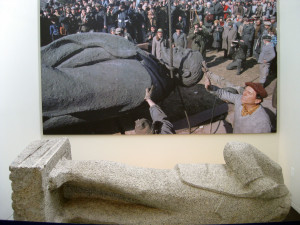
In 1991, the city of Berlin demolished a 62-foot-high monument of Lenin in an attempt to leave its East/West divisions behind. Smashed to pieces, remnants of the statue were buried—with the head hidden in a sandpit on the outskirts of the city. Twenty-four years later, organizers of a museum exhibition are scheduling a showcase of around 100 historical monuments from Berlin. The 3.5 ton head would undoubtedly be a crowd-pulling highlight, laying bare the city’s communist past.
The exhibition is meant to provide an objective look at the city’s turbulent history. Indeed, this embracement of contentious monuments goes against the wake of recent reactions to Soviet relics in many former republics of the U.S.S.R. — and falls in line with Germany’s tendency to thoroughly acknowledge and display its less impressive historical moments. However, the project has stirred opposition to a perceived form of communist revival, and city officials have not failed to raise administrative barriers to the uprooting of the head.
Yet the final obstacle is neither political nor ideological: It is reptilian. Home to a colony of sand lizards, the sandpit containing Lenin’s head cannot be disturbed in the lead up to the creatures’ mating season. Biologists are thus helping excavators to navigate European wildlife conservation laws by drawing the lizards away from the Lenin site.
When Lenin’s debut at “Unveiled: Berlin and its Monuments” will take place is still uncertain.
[SOURCES:]
http://www.dw.de/berlin-lizards-impede-lenins-resurrection/a-18386865
David Crossland. “Berlin’s Lizards Impend Lenin’s Resurrection.” Deutsche Welle, April 18, 2015. Accessed April 20, 2015. http://www.dw.de/berlin-lizards-impede-lenins-resurrection/a-18386865.
http://www.vocativ.com/culture/art-culture/berlin-begins-search-lenins-head/
Joel Stonington. “Berlin Begins the Search for Lenin’s Head.” Vocativ, September 24, 2014. Accessed April 20, 2015. http://www.vocativ.com/culture/art-culture/berlin-begins-search-lenins-head/.
http://www.abendblatt.de/vermischtes/article205230097/Der-alte-Lenin-hat-eine-Eidechse-auf-dem-Kopf.html
Ulli Kulke. “Der alte Lenin hat eine Eidechse auf dem Kopf.” Hamburger Abendblatt, March 30, 2015. Accessed April 20, 2015. http://www.abendblatt.de/vermischtes/article205230097/Der-alte-Lenin-hat-eine-Eidechse-auf-dem-Kopf.html.
-
By Maryna Polataiko for postcommunistmonuments.ca
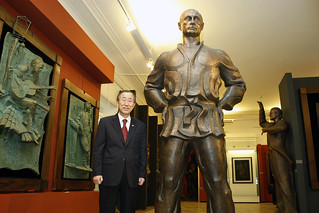
Adorned with laurels, armor and a toga, a new Roman-emperor-style bust of Russian President Vladimir Putin has entered into the world. The initiative to erect the bronze-cast Putin was spearheaded by St. Petersburg Cossacks, with sculptor Pavel Greshnikov creating the likeness of the ruler. The idea to commemorate Putin came in the wake of Russia’s annexation of Eastern Ukraine, which Ataman of the St. Petersburg Cossacks Andrei Polyakov says is bringing the Russian empire back together again.
This is not the first sculpture of Putin clad in curious attire. Pictured is UN Secretary-General Ban Ki-moon posing with a grandiose monument to Putin at the Tsereteli Gallery in Moscow. Naturally, the Russian President is wearing Judo gear.
Putin’s bust will be revealed on May 9, 2015 (‘Victory Day’) at a metro station at the edge of St. Petersburg, the emperor’s hometown.
[SOURCES:]
http://www.rferl.org/content/cossacks-putin-statue-as-roman-emporer/26909584.html
“Cossacks Plan Victory Day Bust of Putin As Roman Emperor.” Radio Free Europe, March 19, 2015. Accessed March 23, 2015. http://www.rferl.org/content/cossacks-putin-statue-as-roman-emporer/26909584.html.
http://www.mirror.co.uk/news/world-news/vladimir-putin-depicted-roman-emperor-5385828
Dominic Smith. “Vladimir Putin to be Depicted as Roman Emperor in Statue Built in His Hometown.” Mirror, March 23, 2015. Accessed March 23, 2015. http://www.mirror.co.uk/news/world-news/vladimir-putin-depicted-roman-emperor-5385828.
http://rusmania.com/central/moscow-federal-city/moscow/khamovniki/?s=russian-academy-of-arts-and-zurab-tsereteli-gallery
“Russian Academy of Arts and Zurab Tsereteli Gallery. RusMania. Accessed March 23, 2015. http://rusmania.com/central/moscow-federal-city/moscow/khamovniki/?s=russian-academy-of-arts-and-zurab-tsereteli-gallery.
-
By Maryna Polataiko for postcommunistmonuments.ca
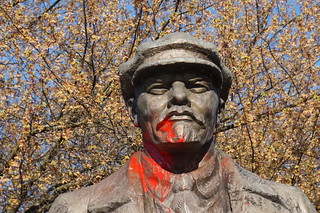
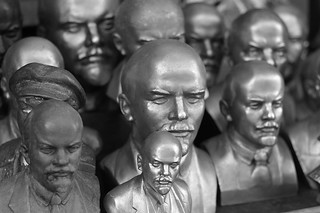
In his dissertation, Dr. Richard Clay—art historian at the University of Birmingham and art TV show host—wrote in defense of the iconoclasts who brought down la Barriere de la Conference. They, he said, “used the sculptures at the gate as a resource for public protest and as a means of signifying the political positions of those involved” (PDF linked below). To this day, he examines the deeds of the sans culottes in a positive light on his TV programme.
One cannot help but draw parallels between the recent ‘Lenin-O-Fall’ in Ukraine—a surge of activist demolitions targeting statues of Lenin. During the Soviet era, it was mandated that every town erect a statue of Lenin. With Ukraine’s annexation on the backdrop, the demolition of Lenins across the country functions is an anti-Soviet—and thus anti-Russian—outlet. Yet the merit of destroying France’s royalist symbols is under debate. Undoubtedly then, the same questions surround Lenin-O-Fall.
Justinian A. Jampol, founder and executive director of The Wende Museum and Archive of the Cold War in Culver City, California questions the advantages of Lenin-O-Fall. Writing for The New York Times, he argues that erasing memories of the Soviet regime will prevent the reflection necessary for a proper healing process. Tearing down Lenins, he contends, will not piece together a divided nation. Yet to proponents, the idea of conserving monuments that commemorate a figure blamed for political repression and deaths, seems to do the opposite. Rather than providing spaces for contemplation, it incurs a reliving of past traumas.
Whatever the philosophy backing Lenin-O-Fall, the magnitude of the movement is so grand that an online database documenting each demolition has been created (linked below).
For an in-depth examination of the Fall, check out Radio Free Europe’s podcast, ‘Goodbye Lenin.’
[SOURCES:]
http://www.nytimes.com/2014/03/04/opinion/smashing-lenin-wont-save-ukraine.html?_r=0
Jastinian A. Jampol. “Smashing Lenin Won’t Save Ukraine.” The New York Times, March 3, 2015. Accessed March 4, 2015. http://www.nytimes.com/2014/03/04/opinion/smashing-lenin-wont-save-ukraine.html?_r=0.
http://www.radiotimes.com/episode/cvyksb/the-french-revolution-tearing-up-history
Patrick Mulkern. “The French Revolution: Tearing Up History.” RadioTimes. Accessed April 30, 2015. http://www.radiotimes.com/episode/cvyksb/the-french-revolution-tearing-up-history.
http://www.themoscowtimes.com/news/article/ukraine-region-plans-mass-purge-of-soviet-lenin-monuments/509473.html
“Ukraine Region Plans Mass Purge of Soviet Lenin Monuments.” The Moscow Times, October 15, 2015. Accessed November 25, 2014. http://www.themoscowtimes.com/news/article/ukraine-region-plans-mass-purge-of-soviet-lenin-monuments/509473.html.
http://www.rferl.org/content/podcast-goodbye-lenin/26976711.html
“Podcast: Goodbye, Lenin.” Radio Free Europe, April 24, 2015. Accessed April 30, 2015. http://www.rferl.org/content/podcast-goodbye-lenin/26976711.html.
http://leninstatues.ru/skolko
«Сколько всего памятников Ленину?» [How Many Monuments to Lenin Total?] Памятники Ленину [Monuments to Lenin]. Accessed November 2, 2014.
-
- May 28, 2015 - 11:30 pm
- Armenia, WWII
- Comments Off on Armenia Celebrates Victory Day
By Maryna Polataiko for postcommunistmonuments.ca

Photo: Armenian Genocide Monument
While countries such as Ukraine and Uzbekistan are using the 70th anniversary of Nazi Germany’s defeat to spurn ties with Russia, Armenia is celebrating the occasion and is—simultaneously—strengthening ties with its former Soviet ringleader.
Earlier this spring, members of the CIS Inter-Parliamentary Assembly joined the Vice President of the Armenian National Assembly Hermine Naghdalyan in the “Memory Baton” ceremony honouring the anniversary. Drawing fire from the eternal flame in Yerevan, Russian delegates traveled back to Russian with the Armenian torch in order to add fire to a flame in St. Petersburg, where all the CIS members’ fires collide.
On March 30, Chairman of the Russian State Duma Sergey Naryshkin arrived in Armenia for a tree-planting ceremony at the new Alley of Victory (located at the Armenian-Russian University) and was joined by Armenian Speaker of the National Assembly Galust Sahakyan. This event symbolized friendly relations between both states. Following the ceremony, a forum honouring the Great Victory took place. There, Shakyan drew parallels between the 70th anniversary of the Nazi defeat and the centennial of the Armenian genocide.
Among other events, resources have been allocated to erecting and maintaining monuments honouring the War.
In Russia, an Armenian temple in Moscow was blessed by Archbishop Yezras Nersisyan (Russian and Novo-Nakhchivan Eparchy of the Armenian Apostolic Church) to commemorate soldiers from the World Wars.
Joint parades of Russian and Armenian soldiers are scheduled to take place May 9 in Gyumri and Yerevan.
[SOURCES:]
http://arka.am/en/news/politics/armenia_to_celebrate_victory_in_great_patriotic_war_at_a_high_level_government/
“Armenia to Celebrate Victory in Great Patriotic Was at a High Level—Government.” ARKA News Agency, March 30, 2015. Accessed April 2, 2015. http://arka.am/en/news/politics/armenia_to_celebrate_victory_in_great_patriotic_war_at_a_high_level_government/.
http://armenpress.am/eng/news/799737/armenian-and-russian-parliamentary-speakers-participated-in-forum-devoted-to-victory-in-great-patriotic.html
“Armenian and Russian Parliamentary Speakers Participated in Forum Devoted to Victory in Great Patriotic War.” Armenpress, March 30, 2015. Accessed April 2, 2015. http://armenpress.am/eng/news/799737/armenian-and-russian-parliamentary-speakers-participated-in-forum-devoted-to-victory-in-great-patriotic.html.
http://armenpress.am/eng/news/798917/armenia-also-joined-great-patriotic-war-memory-baton.html
“Armenia Also Joined Great Patriotic War ‘Memory Baton.’” Armenpress, March 24, 2015. Accessed April 2, 2015. http://armenpress.am/eng/news/798917/armenia-also-joined-great-patriotic-war-memory-baton.html.
http://vestnikkavkaza.net/news/society/68431.html
“Marathon of Memory Reaches Armenia.” Vestnik Kavkaza, March 25, 2015. Accessed April 2, 2015. http://vestnikkavkaza.net/news/society/68431.html.
http://arka.am/en/news/society/cis_inter_parliamentary_assembly_members_pay_floral_tribute_to_world_war_ii_victims_in_victory_park_/
“CIS Inter-Parliamentary Assembly Members Pay Floral Tribute to World War II Victims in Victory Park in Yerevan.” ARKA News Agency, March 24, 2015. Accessed April 2, 2015. http://arka.am/en/news/society/cis_inter_parliamentary_assembly_members_pay_floral_tribute_to_world_war_ii_victims_in_victory_park_/.
http://vestnikkavkaza.net/news/society/69826.html
“Spot for Armenian Temple Blessed on Moscow’s Poklonnaya Hill.” Vestnik Kavkaza, April 20, 2015. Accessed April 20, 2015. http://vestnikkavkaza.net/news/society/69826.html.
http://www.panorama.am/en/press/2015/04/16/hzh2/
“Haykakan Zhamanak: Armenian and Russian Servicemen to Conduct Parades in Yerevan and Gyumri.” Panorama, April 16, 2015. Accessed April 20, 2014. http://www.panorama.am/en/press/2015/04/16/hzh2/.
http://arka.am/en/news/politics/memory_alley_dedicated_to_70_anniversary_of_soviet_people_s_victory_over_nazis_opened_in_yerevan/
“Memory Alley Dedicated to 70 Anniversary of Soviet People’s Victory over Nazis Opened in Yerevan.” ARKA News Agency, April 3, 2015. Accessed April 12, 2015. http://arka.am/en/news/politics/memory_alley_dedicated_to_70_anniversary_of_soviet_people_s_victory_over_nazis_opened_in_yerevan/.
-
- May 28, 2015 - 11:27 pm
- Ukraine
- Comments Off on Ukraine: Erasing Communism?
By Maryna Polataiko for postcommunistmonuments.ca
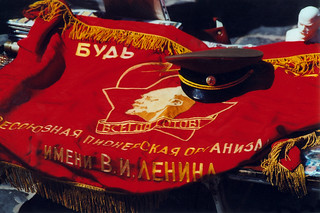
Ukraine’s recent past has been anything but calm. Two fresh revolutions under its belt, a presidential ousting, and the Russian conflict in Crimea and the Donbas. The common thread among these events? Ukraine’s Soviet legacy, which the country is trying to eradicate, and prevent it from coming back for a round two. Recently, Ukraine took a legislative measure to fight against its Soviet past.
While the passing of a bill may not be as gripping a maneuver against Russia compared to mass protests, the Verhovna Rada’s decision to ban communist and Nazi propaganda and symbols is a quantum step in (re)claiming history, national memory, and public space from the grip of Russian imperial master narratives. This was not the first of measures taken to reclaim public space. Activists across the country have been participating in ‘Lenin-O-Fall’—the demolition of Lenin statues. A debate on whether or not to remove Soviet military commander Nikolai Vatutin’s monument in Kyiv is now taking place, and the hammer and sickle have been replaced with the iconic Ukrainian Tryzub (Trident) on the gates of Ukraine’s parliamentary building.
With Ukraine’s new law, any organizations (political, media, etc.) charged with the propagation of communism or Nazism will be shut down and investigated, with the results made available to the public.
After the law was passed, Ukrainian activists in the city of Dnipropetrovsk brought down another statue of Lenin. Two days after the law was passed, a series of statues in Kharkiv were destroyed—including a sculpture of Russian hero Nikolay Rudnev, made by Soviet sculptor Viktor Volovik.
In response to the ban on communist and Nazi propaganda, Russia’s foreign ministry stated that the law would lead to “rewriting history” and advance “nationalist ideology.” However, Alexander J. Motyl, professor of political science at Rutgers University, states that according to a study by the Moscow-based Institute of Demography, Ukraine “suffered close to 15 million ‘excess deaths’ between 1914 and 1948. Of that total, about 7.5 million were attributed to Soviet policies and 6.5 million to the Nazis,” concluding that de-Nazification and decommunization are both crucial; the latter allowing Ukraine to overcome its totalitarian past and move along a pro-Western trajectory.
From this angle, the former Soviet republic is reclaiming its history, free of colonial dogmas of Soviet, Russian, and neo-Soviet ideologies. Irrespective of value judgments, Ukraine is indeed rewriting the narrative by reclaiming its public spaces.
[SOURCES:]
https://www.foreignaffairs.com/articles/ukraine/2015-04-28/kievs-purge
Alexander J. Motyl. “Kiev’s Purge: Behind the New Legislation to Decommunize Ukraine.” Foreign Affairs, April 28, 2015. Accessed May 1, 2015. https://www.foreignaffairs.com/articles/ukraine/2015-04-28/kievs-purge.
http://krytyka.com/en/solutions/opinions/decommunization-and-academic-discussion
Volodymyr Viatrovych. “’Decommunization’ and Academic Discussion.” Krytyka, May 2015. Accessed May 3, 2015. http://krytyka.com/en/solutions/opinions/decommunization-and-academic-discussion.
http://uatoday.tv/geopolitics/ukraine-bans-communist-and-nazi-regime-propaganda-420628.html
“Ukraine Bans Communist and Nazi Regime Propaganda.” UT: Ukraine Today, April 10, 2015. Accessed April 12, 2015. http://uatoday.tv/geopolitics/ukraine-bans-communist-and-nazi-regime-propaganda-420628.html.
http://www.newsweek.com/ukraine-purges-symbols-its-communist-past-321663
Nolan Peterson. “Ukraine Purges Symbols of Its Communist Past.” Newsweek, April 10, 2015. Accessed April 12, 2015. http://www.newsweek.com/ukraine-purges-symbols-its-communist-past-321663.
http://www.theguardian.com/world/2015/apr/20/ukraine-decommunisation-law-soviet
Lily Hyde. “Ukraine to Rewrite Soviet History with Controversial ‘Decommunization” Laws.” The Guardian, April 20, 2015. Accessed April 20, 2015. http://www.theguardian.com/world/2015/apr/20/ukraine-decommunisation-law-soviet.
http://www.bignewsnetwork.com/index.php/sid/231877175
“Dispute Rages Over Soviet General’s Grave in Ukraine.” Big News Network, April 12, 2015. Accessed April 12, 2015. http://www.bignewsnetwork.com/index.php/sid/231877175.
http://uatoday.tv/news/soviet-symbol-on-verkhovna-rada-s-gates-replaced-by-the-coat-of-arms-of-ukraine-419410.html
“Soviet Symbol on Verkhovna Rada’s Gates Replaced by the Coats of Arms of Ukraine.” UT: Ukraine Today, April 3, 2015. Accessed April 5, 2015. http://uatoday.tv/news/soviet-symbol-on-verkhovna-rada-s-gates-replaced-by-the-coat-of-arms-of-ukraine-419410.html.
https://news.artnet.com/in-brief/ukraine-russia-soviet-artwork-287324
Henri Neuendorf. “Soviet Art Smashed in Ukraine After Controversial New Law Bans Nazi and Communist Symbols.” ArtnetNews, April 13, 2015. Accessed April 14, 2015. https://news.artnet.com/in-brief/ukraine-russia-soviet-artwork-287324.
-
- May 28, 2015 - 11:25 pm
- Uzbekistan, WWII
- Comments Off on Uzbekistan: Victory or Remembrance?
By Maryna Polataiko for postcommunistmonuments.ca
May 8, 2015, marks the 70th anniversary of the Nazi defeat in World War II. Some have been exultantly calling it “Victory Day” and others solemnly referring to it as the “Day of Remembrance.” While Russia has been preparing to celebrate and commemorate the ‘Great Patriotic War,’ some former U.S.S.R. republics are less keen to embrace what they see as a day lauding the Soviet exploitation of soldiers drafted for the campaign. Uzbekistan, for example lost tens of thousands in the effort against the Axis powers.
Thus it is probably not an accident that the city authorities of Angren (Uzbekistan) have recently torn down a Soviet statue commemorating the 25th anniversary of the Soviet triumph. The removal of the memorial on March 19, assert Angren officials, is simply a component of a larger city development scheme.
[SOURCES:]
http://www.rferl.org/content/uzbeks-demolish-ww2-memorial/26911293.html
“Uzbeks Demolish World War II Memorial Ahead of Anniversary.” Radio Free Europe, March 20, 2015. Accessed March 20, 2015. http://www.rferl.org/content/uzbeks-demolish-ww2-memorial/26911293.html.
http://www.satrapia.com/news/article/uzbeks-demolish-world-war-ii-memorial/
“Uzbeks Demolish World War II Memorial.” The Gazette of Central Asia, March 20, 2015. Accessed March 20, 2015. http://www.satrapia.com/news/article/uzbeks-demolish-world-war-ii-memorial/.
http://www.washingtonpost.com/blogs/worldviews/wp/2015/03/25/70-years-later-the-world-is-still-fighting-world-war-ii/
Isaah Tharoor. “70 Years Later the World is still Fighting World War II.” Washington Post, March 25, 2015. Accessed March 30, 2015. http://www.washingtonpost.com/blogs/worldviews/wp/2015/03/25/70-years-later-the-world-is-still-fighting-world-war-ii/.
-
By Maryna Polataiko for postcommunistmonuments.ca
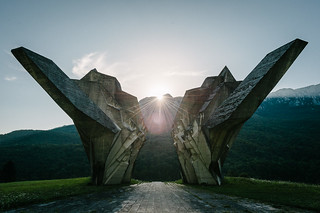
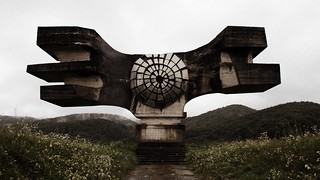
They were built in the 60s and 70s. They were later deemed “abandoned.” Yet for something so allegedly antiquated, people cannot seem to forget them. The enduring memory of the Spomeniks is not unbefitting, for their name describes just that: the monuments. Commissioned by Josep Broz Tito in the wake of the Second World War, the series of behemoth structures designed by various sculptors and architects (Miodrag Živković, Dušan Džamonja, Gradimir Medaković, Bogdan Bogdanović et al.) were built to commemorate the lives of soldiers lost in combat. Each monument, evasive of flouting for whom it stands, is positioned on battlegrounds across the former Yugoslavia. Following the victory against German occupation, the Spomenik served as a unifier to a new confederation.
But after the brutal disbanding of Yugoslavia, the concrete alien configurations became ghostly reminders of a failed socialist regime. Having lost their salience in their home countries, the monuments went into a slumber until 2010 when Belgian photographer Jan Kempenaers resurrected them into the international spotlight. Since then, the Yugoslavian monuments have transcended national boundaries and have drawn the attention of artists and scholars alike.
Perhaps most striking is artist Aleksandra Domanović’s appropriation of the spomenik. For the 4th Marrakech Biennale in 2012, Domanović recreated one of the fist monuments from Bubanj Memorial Park in Niš (Serbia), designed by Croatian sculptor Ivan Sabolić in 1963. But the structure is far from a carbon copy. Her version is 6 meters tall, made of wood, and gleaming with bright pink tadelakt—a traditional Moroccan finishing process. Domanović left spectators with a strangely recontextualized monument, melding signifiers of Yugoslavian socialism with a Moroccan environment.
In 2014, the spomeniks were showcased in a video by Croatian artist Igor Grubic at the ‘Concrete’ exhibition at the Monash University Museum of Art (MUMA) in Melbourne (Australia). His work explores memorials as well as historical erasure. Amsterdam-based Serbian artist Kristina Benjocki’s ongoing multimedia project, ‘Past, Less Predictable Than the Future’ explores politics and memory through the Yugoslavian memorials as well. Vladimir Kulić—assistant professor of architectural history and theory at Florida Atlantic University—has received a grant from the Graham Foundation to examine the works of Serbian-Yugoslav architect Bogdan Bogdanović—whose work includes the Jasenovac Memorial Complex, in Jasenovac, Croatia.
This April, the Baltic Centre for Contemporary Art, Newcastle (UK) is holding a seminar on socialist Yugoslavia’s modernist architecture. To say that Tito’s monuments have been forgotten could not be further from the truth.
[SOURCES:]
http://drainmag.com/speaking-of-time-the-ethics-and-aesthetics-of-cultural-mortality-the-politics-of-framing-yugoslavias-spomenik-post-89/
Yasmin Nurming-Por. “Speaking of Time: The Ethics and Aesthetics of Framing Yugoslavia’s Spomenik Post ’89.” Drain Magazine 11, no. 2 (2014). Accessed April 15, 2015. http://drainmag.com/speaking-of-time-the-ethics-and-aesthetics-of-cultural-mortality-the-politics-of-framing-yugoslavias-spomenik-post-89/.
http://www.averyreview.com/issues/1/partial-recall
Chan, Carson. ‘The Avery Review | Partial Recall: A Brief Account Of Aleksandra Domanović’s Monuments And The Aesthetics Of The Near Obsolete.’ Averyreview.com. N.p., 2015. Accessed April 1, 2015.
http://www.smh.com.au/entertainment/art-and-design/concrete-exhibition-explores-monumental-themes-20140506-zr5f0.html#ixzz3Wqq3BF5P
Dan Rule. “Concrete Exhibition Explores Monumental Themes.” The Sydney Morning Herald, May 6, 2014. Accessed April 15, 2015. http://www.smh.com.au/entertainment/art-and-design/concrete-exhibition-explores-monumental-themes-20140506-zr5f0.html#ixzz3Wqq3BF5P.
http://www.grahamfoundation.org/grantees/5159-architecture-s-expanded-field-bogdan-bogdanovic-and-an-alternative-genealogy-of-postmodernism
Vladimir Culić. “Architecture’s Expanded Field: Bogdan Bogdonović and the Alternative Genealogy of Postmodernism.” Graham Foundation. Accessed April 15, 2015. http://www.grahamfoundation.org/grantees/5159-architecture-s-expanded-field-bogdan-bogdanovic-and-an-alternative-genealogy-of-postmodernism.
-
By Maryna Polataiko for postcommunistmonuments.ca
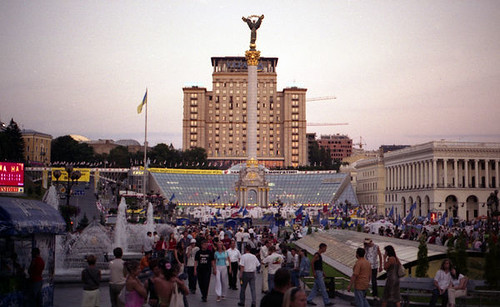
Last year, the Kyiv City State Administration and Ukraine’s Ministry of Culture kicked off a competition asking Ukrainians to design a memorial commemorating the Heavenly Hundred Heroes—those who died at the Maidan Nezalezhnosti. Today, the competition for the project, “Terra Dignitas: Reinventing Public Space in Kyiv’s City Core and Commemorating the Revolution of Dignity,” is soliciting proposals for the entire surrounding space, worldwide.
Competition on the best project/design of the “Museum of Maidan” ignited a robust discussion in social networks. There are 24 submissions in this category, with 148 project proposals all in all—with ideas ranging from an “angel with a cross to light art installation”—competing in 4 categories. The remaining categories concern the design of the space of Maidan and Kyiv`s city core (with 29 competing projects), the commemoration the Revolution of Dignity and memory of the Heavenly Hundred Heroes (boasting a whopping 86 proposed projects), and the International cultural center "Ukrainian House on European Square" (9 projects).
Public discussion and polling will continue until the beginning of May, and then the results will be given to a professional jury.
In recent discussions, it has been agreed that the renovation of the Maidan into a beautiful and inviting public space—including benches, fountains, and playgrounds—should take priority over museums and monuments. University Lecturer Vladyslava Osmak suggests that the area ought to be a place of celebration and healing rather than a place of mourning.
There will be a “memory lane” and a museum to commemorate the Heavenly Hundred, but Osmak asserted: “not a Soviet-style monument.”
[SOURCES:]
http://terradignitas.kga.gov.ua/en/
Міжнародний відкритий конкурс «Територія гідності»/International Open competition “Terra Dignitas.” Accessed December 15, 2014. http://terradignitas.kga.gov.ua/en/.
http://www.archdaily.com/563584/city-of-kyiv-launches-terra-dignitas-revolution-memorial-competition/
Rory Stott. “City of Kyiv Launches ‘Terra Dignitas’ Revolution Memorial Competition.” ArchDaily, November 1, 2014. Accessed November 15, 2014. http://terradignitas.kga.gov.ua/en/.
http://mignews.com.ua/regiony/kiev/5308128.html
http://news.yahoo.com/museum-memory-lane-kiev-mulls-memorial-maidan-victims-191145241.html
Claire Rosemberg and Olga Shylenko. “Museum or Memory Lane? Kiev Mulls Memorial to Maidan Victims.” Yahoo News, April 17, 2015. Accessed April 18, 2015. http://news.yahoo.com/museum-memory-lane-kiev-mulls-memorial-maidan-victims-191145241.html.
http://dyvys.info/kultura/do-stvorennya-pam-yatnoho-memorialu-heroyam-nebesnoji-sotni-pryjednayutsya-mizhnarodni-myttsi-foto.html
«До створення пам'ятного меморіалу Героям Небесної Сотні приєднаються міжнародні митці.» дивись.inf, November 14, 2014. Accessed December 5, 2014. http://dyvys.info/kultura/do-stvorennya-pam-yatnoho-memorialu-heroyam-nebesnoji-sotni-pryjednayutsya-mizhnarodni-myttsi-foto.html.
http://www.mediemix.com.ua/detail/196996-Від-янгола-з-хрестом-до-світової-інсталяції-яким-стане-Майдан
«Від янгола з хрестом до світової інсталяції: яким стане Майдан.» MEDIEMIX. TV 24, April 7, 2015. Accessed April 25, 2015. http://www.mediemix.com.ua/detail/196996-Від-янгола-з-хрестом-до-світової-інсталяції-яким-стане-Майдан.
-
By Maryna Polataiko for postcommunistmonuments.ca
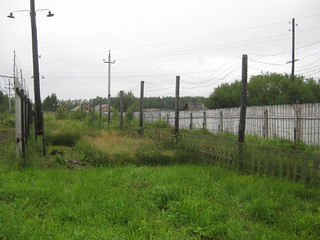
When hearing ‘gulag,’ many will associate the labor camps with the U.S.S.R.’s Stalinist era. Thus, some may be surprised to hear that the last camp holding political dissidents only closed in 1988. Located in the Urals, Perm-36 is the last intact camp standing in Russia. The site, since then, was converted to a museum on Soviet repression.
But in the wake of Russia’s historical revisionism, Perm-36 is in trouble. After 20 years of operation, the historians managing the museum were supplanted by a state organization looking to change the historical narrative offered by the site. In light of the recent surge of approval ratings for Stalin, this shift comes as no surprise.
Lately, Perm-36 has been the target of various investigations—the most recent focusing on accusations of the museum being a “foreign agent.” A recent Russian law stipulates that any domestic NGO accepting foreign funds must be documented as a “foreign agent”—a label evoking Cold War tensions and suspicion.
Original plans to commemorate the victims of Soviet repression have been replaced by projects such as an anti-fascist World War II memorial, and an event celebrating Aleksandr Solzhenitsyn—a gulag prisoner upholding ‘appropriate’ nationalist ideals. It is noteworthy that the first exhibition under the new state leadership will be devoted to the guarding system and technical aspects of incarceration. The focus will radically change, shifting from political prisoners, repressions, and Stalin’s crimes to the camp system in general.
[SOURCES:]
http://gulaghistory.org/nps/onlineexhibit/stalin/perm36.php
“Gulag: Soviet Forced Labor Camps and the Struggle for Freedom.” Gulag Museum. Accessed April 25, 2015. http://gulaghistory.org/nps/about/history.php.
http://www.telegraph.co.uk/news/worldnews/europe/russia/11481113/Russias-only-gulag-museum-faces-closure.html
Roland Oliphant. “The Only Russian Gulag Preserved as a Museum is Under Investigation for Accepting Foreign Donations.” The Telegraph, March 20, 2015. Accessed March 17, 2015. http://www.telegraph.co.uk/news/worldnews/europe/russia/11481113/Russias-only-gulag-museum-faces-closure.html.
http://www.rferl.org/content/russia-perm-liberal-bastion-no-more/26911622.html
Tom Balmforth. “Perm’s Big Chill.” Radio Free Europe, March 20, 2015. Accessed March 20, 2015. http://www.rferl.org/content/russia-perm-liberal-bastion-no-more/26911622.html.
http://www.rferl.org/media/video/russia-gulag-perm/26918475.html
“Whitewashing Russia’s Gulag History.” Radio Free Europe, March 24, 2015. Accessed March 30, 2015. http://www.rferl.org/media/video/russia-gulag-perm/26918475.html.
http://www.newsru.com/russia/05mar2015/gulag.html
«'Пермь-36' станет музеем паботников ГУЛАГА, все упоминания о репрессиях и Сталине уберут.» NewsRu.com, March 5, 2015. Accessed March 10, 2015. http://www.newsru.com/russia/05mar2015/gulag.html.
-
- May 28, 2015 - 11:16 pm
- Bulgaria
- Comments Off on Mihov's "Forget Your Past"
By Maryna Polataiko for postcommunistmonuments.ca
Bulgaria-born photographer Nikola Mihov has taken it upon himself to help preserve the memory of his country’s communist past. Named after graffiti hanging over the doors of the Bulgarian Communist Party Memorial, Mihov’s “Forget Your Past” photo series tells spectators to do just the opposite. Mihov documents key monuments from Bulgaria’s communist period, many of them left in a state of decrepitude.
While many of these relics were demolished following the end of the communist regime, many have survived. Since 2009, Mihov has been exploring Bulgaria to find them.
[SOURCES:]
http://www.nikolamihov.com/forget-your-past
Nikola Mihov. “Forget Your Past.” Accessed September 5, 2014. http://www.nikolamihov.com/forget-your-past.
http://www.archdaily.com/101626/forgotten-monuments-from-the-communist-era-in-bulgaria/
Alison Furuto. “Forgotten Monuments From the Communist Era in Bulgaria.” ArchDaily, January 10, 2010. Accessed September 5, 2014. http://www.archdaily.com/101626/forgotten-monuments-from-the-communist-era-in-bulgaria/.
http://www.bulgarianphotographynow.com/en/Portfolio/forget-your-past
Nikola Mihov. “Forget Your Past, 2009-2012.” Bulgarian Photography Now. Accessed September 10, 2014. http://www.bulgarianphotographynow.com/en/Portfolio/forget-your-past.
http://www.ekathimerini.com/4dcgi/_w_articles_wsite4_1_27/03/2015_548587
Harry van Versendaal. “Communist Structures Risk Fate of Ozymandias.” Ekathemerini.com, March 27, 2015. Accessed April 1, 2015. http://www.ekathimerini.com/4dcgi/_w_articles_wsite4_1_27/03/2015_548587.
-
By Maryna Polataiko for postcommunistmonuments.ca
Monuments in Africa, made in North Korea, inspired by the Soviet Union!
Commissioned by Senegal, Pyongyang’s Mansudae Overseas Projects is responsible for the 160-foot African Renaissance Monument erected in 2006. Operated by the North Korean government, Mansudae’s factory specializes in the production of gargantuan—yet fairly inexpensive—monuments largely inspired by a Soviet aesthetic.
Purportedly embodying the end of Senegal’s colonial history, the statue was ordered by former president Abdoulaye Wade. Mansudae’s sculptures brandish the earmarks of Socialist realism, depicting sharp figures, larger than life and imbued with state ideology. This Soviet motif, however, is not limited to the outskirts of Dakar.
Senegal is among 18 other states that are home to Mansudae monuments. The majority of countries outsourcing to the Pyongyang-based company find themselves in Africa and Asia. Apparently, the legacy of the U.S.S.R.’s aesthetic regime crosses continental boundaries.

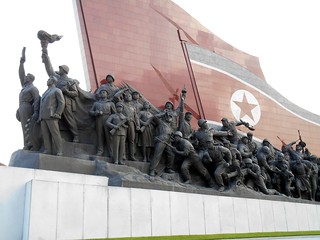

From top to bottom: African Renaissance Monument, two other Mansudae monuments
[SOURCES:]
https://news.artnet.com/art-world/the-north-korean-art-factory-cranking-out-soviet-style-monuments-73226
Sarah Cascone. “The North Korean Art Factory Cranking Out Soviet-Style Monuments.” ArtNet, August 5, 2014. Accessed September 5, 2014. https://news.artnet.com/art-world/the-north-korean-art-factory-cranking-out-soviet-style-monuments-73226.
http://www.slate.com/blogs/atlas_obscura/2014/08/04/the_african_renaissance_monument_in_dakar_senegal.html
Ella Morton. “The Controversial Senegalese Monument Built by North Korean Propaganda Artists.” Atlas Obscura, August 4, 2014. Accessed September 30, 2014. http://www.slate.com/blogs/atlas_obscura/2014/08/04/the_african_renaissance_monument_in_dakar_senegal.html.
http://artcocktail.mallforarts.com/2014/12/the-north-korean-monuments-in-africa/
Victor. “The North Korean Monuments in Africa.” Art Cocktail, December 1, 2014. Accessed December 10, 2014. http://artcocktail.mallforarts.com/2014/12/the-north-korean-monuments-in-africa/.
-
- May 28, 2015 - 11:08 pm
- Poland, Russia, WWII
- Comments Off on Putting the Sleepers to Sleep
By Maryna Polataiko for postcommunistmonuments.ca
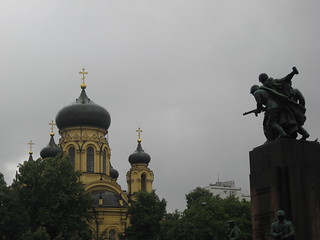
On November 18th 1945, a statue depicting seven soldiers was raised on Wileński Square in Warsaw. On a tall, tiered base: Three Soviet soldiers stand ready for combat. Below, four Polish soldiers—the ‘Four Sleeping Soldiers’—stand guard. Celebrating the defeat of Nazi Germany, the monument recognized the Soviet Red Army’s contribution to Poland’s independence. More broadly, the monument stood as a symbol for Soviet-Polish friendship. Yet the sleeping soldiers were not taken down following the collapse of the U.S.S.R.
Only in 2011 were they taken down temporarily due to construction work being done on Warsaw’s metro system. In line with a 1994 intergovernmental agreement concerning war memorials, Warsaw officials agreed to return the monument post-construction. Its return, however, was met with public opposition. Today, the soldiers represent an outdated and unwanted Communist presence, coupled with the reminder of Poland’s involuntary friendship with Russia.
In late February, Warsaw’s city council voted to hide the monument in a storeroom instead of returning it to Wileński Square. Amidst Polish-Russian tensions over Ukraine’s annexation, the decision to hide the monument is anything but apolitical.
Russia has accused Poland of a disrespectful attitude to the monuments to Soviet soldiers. Warsaw asserts that the conflict draws on different understandings of memory about WWII. An expert from the Polish Council says that in Poland, people commemorate the memory of those fallen in the war (there are 630 Soviet soldiers’ cemeteries in Poland, all of them maintained by the state), while Russia honors the monuments, which he calls “the monuments of fraternal arms,” fixtures erected during the period of Soviet control.
[SOURCES:]
http://www.nytimes.com/aponline/2015/02/27/world/europe/ap-eu-poland-soviet-monument.html
“Soviet Monument Banned From Returning to Warsaw Square.” The New York Times, February 27, 2015. Accessed March 15, 2015. http://www.nytimes.com/aponline/2015/02/27/world/europe/ap-eu-poland-soviet-monument.html?_r=1.
http://culture.pl/en/article/comradeship-of-the-sad-and-the-fighting-a-history-of-vanishing-monuments
Filip Lech. “Comradeship of the Sad and the Fighting: A History of Vanishing Monuments.” Culture.Pl, February 17, 2015. Accessed March 1, 2015. http://culture.pl/en/article/comradeship-of-the-sad-and-the-fighting-a-history-of-vanishing-monuments.
http://www.thenews.pl/1/9/Artykul/198554,Sovietera-monument-to-disappear-from-Warsaw%E2%80%99s-Praga-district
“Soviet-Era Monument to Disappear from Warsaw Praga District.” Radio Poland, February 27, 2015. Accessed March 15, 2015. http://www.thenews.pl/1/9/Artykul/198554,Sovietera-monument-to-disappear-from-Warsaw%E2%80%99s-Praga-district.
http://www.radiosvoboda.org/content/article/26987441.html
Юрій Савицький. «Шанування пам'яті померлих чи культ радянських пам'ятників?» Радіо Свобода, May 3, 2015. Accessed May 3, 2015. http://www.radiosvoboda.org/content/article/26987441.htm.
-
- May 28, 2015 - 11:06 pm
- Belarus, WWII
- Comments Off on Belarus and the Great Patriotic War
By Maryna Polataiko for postcommunistmonuments.ca
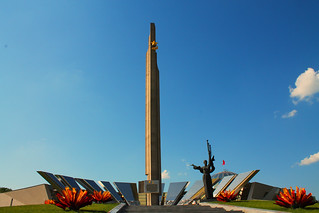
Photo: Belarus Museum of the Great Patriotic War
During a CIS Foreign Ministers Council session in early October 2014, Belarusian Foreign Minister Vladimir Makei announced the state’s intention to cast a spotlight on the Great Patriotic War—the battle between the Soviet Union and Nazi Germany between 1941 and 1945—and its resulting tragedy within the international community. Makei’s goal is to emphasize the sacrifices made by the USSR in the name of “freedom and independence.”
This initiative will not only necessitate the conservation of old monuments to the War, but will require the creation and installation of new ones as well. The restoration of the Belarusian Great Patriotic War Museum located in Minsk is said to be an example of this project.
This March, Moscow’s Central Museum of the Great Patriotic War will be putting on an exhibit called “We were Together in the Fight Against Nazism,” which will consist of items loaned by the Museum of the Great Patriotic War in Minsk.
According to the Belarusian Ministry of Culture, every former Soviet republic will be designated its own display. Anticipated to open in April, the exhibit will be part of a larger commemoration of the 70th anniversary of the battle’s end. The exhibit will be part of a larger Belarus-Russian project held in 2014 to celebrate the victory throughout their museums.
[SOURCES:]
http://eng.belta.by/all_news/politics/Belarus-calls-for-more-attention-to-Great-Patriotic-War
events_i_76365.html
“Belarus Calls For More Attention to Great Patriotic War Events.” Belarusian News: National Source of News, October 9, 2014. Accessed October 23, 2014.
http://eng.belta.by/all_news/culture/Great-Patriotic-War-museums-of-Belarus-Russia-to-hold-joint-exhibition-in-Moscow_i_81156.html
Eng.belta.by. 'Great Patriotic War Museums Of Belarus, Russia To Hold Joint Exhibition In Moscow | Culture | Headlines'. April 23, 2015. Web. Accessed April 25, 2015.
-
- May 28, 2015 - 11:04 pm
- Armenia
- Comments Off on A Statue to Mikoian?
By Maryna Polataiko for postcommunistmonuments.ca
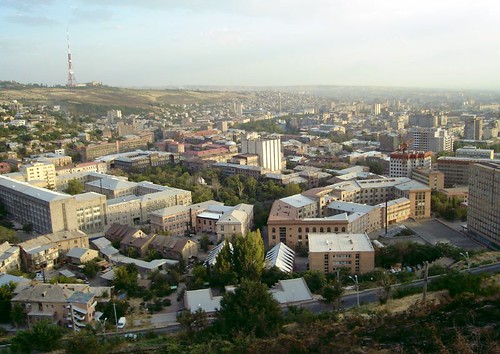
Eliciting public scorn, Yerevan Mayor Taron Margarian authorized the installation of a statue depicting Soviet-era politician Anastas Mikoian. The former statesman—whose career peaked when he briefly occupied the position of Chairman of the Presidium of the Supreme Soviet—was a supporter of Stalin, and is known for his involvement in the purges of the 1930s. In light of Mikoian’s recommendations to execute hundreds of Armenians, and his disregard for the 1915 Ottoman massacre, the name of Anastas Mikoian is met with scorn and derision.
In response, Armenian activists are calling the monument offensive, and are collecting signatures for a petition supporting its removal. Indeed, Yerevan’s pro-Soviet City Council decision is seen by many as a political maneuver paying court to Putin in response to Armenia’s imminent alignment with a Customs Union helmed by Russia.
Mayor Margarian however, countered the backlash by asserting that the inspection of Mikoian’s contentious misdeeds should be left in the hands of historians.
[SOURCES:]
http://www.eurasianet.org/node/68400
Marianna Grigoryan. “Armenia: Controversial Communist to Get Statue in Yerevan?” Eurasianet.org, May 23, 2014. http://www.eurasianet.org/node/68400.
http://asbarez.com/122737/yerevan-government-plans-statue-to-soviet-leader/
“Yerevan Government Plans Statue to Soviet Leader.” Asbarez.com, May 6, 2014. Accessed September 30, 2014. http://asbarez.com/122737/yerevan-government-plans-statue-to-soviet-leader/.
https://iwpr.net/global-voices/stalins-man-mikoyan-get-statue-yerevan
Poghosyan, Yekaterina. “Stalin’s Man Mikoyan to Get Statue in Yerevan.” Global Voices Caucasus, May 29, 2014. Accessed January 18, 2015. https://iwpr.net/global-voices/stalins-man-mikoyan-get-statue-yerevan.
-
- May 28, 2015 - 11:02 pm
- Georgia, Stalin
- Comments Off on Stalin in Georgia
By Maryna Polataiko for postcommunistmonuments.ca
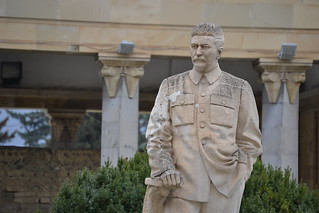
Although recent history has seen a wave of demolition hitting Soviet monuments, small-town Georgia enjoys a contrary sentiment towards memories of the USSR. Marking the anniversary of Stalin’s death, residents of Stalin’s hometown, Gori, gathered before the Stalin Museum to pay tribute. The monument was dismantled in June 2010, under the presidency of Mikheil Saakashvili. However, in July 2013 Georgian Ministry of Culture made a decision to restore the monument based on the petition of the city council of Gori.
Similar support can be found in Tsromi—the town where then runaway Stalin hid from the Tsar—where one of Georgia’s last statues of the dictator remains with the backing of public support. Threatened by Georgia’s prohibition on public displays of Soviet emblems, the statue was moved into Tsromi’s Stalin Museum following a town petition to maintain it.
[SOURCES:]
http://www.straitstimes.com/news/world/europe/story/georgia-marks-the-anniversary-stalins-death-20150306
“Georgia Marks the Anniversary of Stalin’s Death.” The Straits Time, March 6, 2015. Accessed March 20, 2015. http://www.straitstimes.com/news/world/europe/story/georgia-marks-the-anniversary-stalins-death-20150306.
http://qz.com/292901/this-town-is-putting-up-statues-of-stalin-everywhere-even-though-its-illegal/
Caitlin Hu. “This Town is Putting Up Statues of Stalin Everywhere—Even Though It’s Illegal.” Quartz, November 8, 2014. Accessed November 20, 2014. http://qz.com/292901/this-town-is-putting-up-statues-of-stalin-everywhere-even-though-its-illegal/.
http://souciant.com/2015/02/stalin-was-here/
Henry Roe. “Stalin Was Here.” Souciant, February 2014, 2015. Accessed March 1, 2015. http://souciant.com/2015/02/stalin-was-here/.
http://www.apsny.ge/2013/soc/1375150890.php
«Сталин возвращается в Гори.» Грузия Online, July 29, 2013. Accessed October 25, 2014. http://www.apsny.ge/2013/soc/1375150890.php.
-
By Maryna Polataiko for postcommunistmonuments.ca
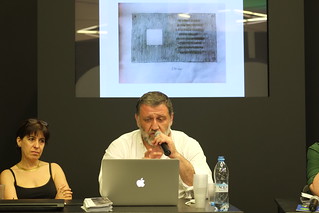
Last year, Russian human rights organization ‘Memorial’ set out to produce and hang commemorative plaques to individual victims of the Soviet regime. Named ‘Last Address,’ the initiative will manufacture inscriptions that can be installed on the former homes of those who were executed or taken to the gulags. The small memorials will provide information on the life of the victim. It will read “Here Lived,” prefacing the name, occupation, dates of birth, arrest and death, as well as that of rehabilitation.
Those who wish to have a plaque made and mounted in memory of someone can pay around 3,500 to 4,000 rubles. The project website provides an interactive map indicating where plaques have been requested or already installed. Starting in Moscow, Memorial aspires to spread its plaques throughout the country.
The project draws on the idea of a well-known European initiative, Stolpersteine (Stumbling Block), started by a German artist Gunter Demnig, over 20 years ago. Since that time the memorial project spread to hundreds of cities and towns in 18 European countries. Within its framework, as of August 2014, over 48,000 stolpersteine commemorating the victims of Nazi regime—predominantly those of Holocaust—have been installed.
[SOURCES:]
http://www.rferl.org/content/last-address-project-aims-to-honor-/26711340.html
Tom Balmforth. “’Last Address’ Project Aims To Honor Victims of Soviet Repression.” Radio Free Europe, November 26, 2014. Accessed December 1, 2014. http://www.rferl.org/content/last-address-project-aims-to-honor-/26711340.html.
http://www.newyorker.com/news/news-desk/humble-memorials-stalins-victims-moscow
Mahsa Lipman. “Humble Memorials For Stalin’s Victims in Moscow.” The New Yorker, December 13, 2014. Accessed December 15, 2014. http://www.newyorker.com/news/news-desk/humble-memorials-stalins-victims-moscow.
http://www.memo.ru/d/180566.html
«Проект 'Последний адрес.'» Мемориал. Accessed October 25, 2014. http://www.memo.ru/d/180566.html.
http://www.stolpersteine.eu/en/
“Stolpersteine: Here Lived 1933-1945. An Art Project for Europe by Gunter Deming.” Stolpersteine. Accessed October 25, 2014. http://www.stolpersteine.eu/en/.
-
- May 28, 2015 - 10:57 pm
- Germany
- Comments Off on Fall of the Wall 25th Anniversary
By Maryna Polataiko for postcommunistmonuments.ca
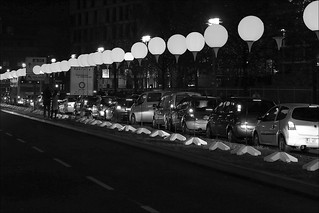
With the fall of the Berlin Wall on November 9 1989, the Cold War reached its closing stages. The year 2014 marked the twenty-fifth anniversary of the long-awaited reconciliation between East and West Berlin. To commemorate the historical event, the city of Berlin erected a “border of light” consisting of 8,000 balloons outlining nine miles of what used to be the wall. Picturesque and seemingly weightless, the radiant orbs set a celebratory tone. Certainly, the impact of the wall is recognized. But the spaced out line of lights emphasizes permeability and a freedom of mobility.
Although the cumulative experience of the fall is well documented, news sources took the opportunity to publish some lesser-known stories and facts behind the monumental event. Hope M. Harrison dispels five common myths surrounding the Berlin Wall. The Local provides a look at the Berlin wall outside of Berlin, telling the story of the outlying hamlet of Mödlareuth that straddles the border between Thuringia and Bavaria. Long divided by geopolitical boundaries, ‘Little Berlin’ too celebrated the collapse of the wall.
Reporting on the fall has been published from various perspectives. Stepping back from social history, Tony Peterson of The Independent details East German leader Eric Honecker’s tenure and eventual demise. Meanwhile, in examining the American perspective, The Washington Post looks at the significance of the Berlin Wall through the eyes of the U.S. art scene.
Although a minute anecdote, a Reddit poster divulges a curious tidbit: That his neighbor has a piece of the Berlin wall on display in his own backyard.
Though a variety of angles have been taken on this historical turning point, there appears to be unity in the jubilation following the fall.
[SOURCES:]
http://www.washingtonpost.com/opinions/five-myths-about-the-berlin-wall/2014/10/30/f6cf1bc4-5df7-11e4-9f3a-7e28799e0549_story.html
Hope M. Harrison. “Five Myths About the Berlin Wall.” Washington Post, October 30, 2014. Accessed December 15, 2014. http://www.washingtonpost.com/opinions/five-myths-about-the-berlin-wall/2014/10/30/f6cf1bc4-5df7-11e4-9f3a-7e28799e0549_story.html.
http://www.thelocal.de/20141030/little-berlin-moedlareuth-remembers-fall-of-its-wall
“’Little Berlin’ Remembers Fall of Its Wall.” The Local, October 30, 2014. Accessed November 5, 2014. http://www.thelocal.de/20141030/little-berlin-moedlareuth-remembers-fall-of-its-wall.
http://www.independent.co.uk/news/world/world-history/fall-of-the-berlin-wall-history-catches-up-with-erich-honecker--the-east-german-leader-who-praised-the-iron-curtain-and-claimed-it-prevented-a-third-world-war-9826715.html
Tony Paterson. “Fall of the Berlin Wall: History Catches Up With Erich Honecker—the East German Leader Who Praised the Iron Curtain and Claimed it Prevented the Third World War.” The Independent, October 29, 2014. Accessed November 15, 2014. http://www.independent.co.uk/news/world/world-history/fall-of-the-berlin-wall-history-catches-up-with-erich-honecker--the-east-german-leader-who-praised-the-iron-curtain-and-claimed-it-prevented-a-third-world-war-9826715.html.
http://www.washingtonpost.com/entertainment/theater_dance/american-artists-find-meaning-in-the-fall-of-the-berlin-wall/2014/10/16/639bd6b8-530b-11e4-b86d-184ac281388d_story.html
Celia Wren. “American Artists Find Meaning in the Fall of the Berlin Wall.” The Washington Post, October 18, 2014. Accessed October 30, 2014. http://www.washingtonpost.com/entertainment/theater_dance/american-artists-find-meaning-in-the-fall-of-the-berlin-wall/2014/10/16/639bd6b8-530b-11e4-b86d-184ac281388d_story.html.
-
- May 28, 2015 - 10:54 pm
- New monument, Poland
- Comments Off on Poland Pays Tribute to Wikipedia
By Maryna Polataiko for postcommunistmonuments.ca
In October 2015, a monument to information-sharing site Wikipedia was erected in Slubice, Poland. Director of Collegium Poloncium—a university located in Slubice— Krzysztof Wojciechowski came up with the idea to construct it. The $14,000, 2-meter brass-like version of Wikipedia’s logo is held up by four human figures, honouring the Wiki community, whose work is integral to the website’s widespread dissemination of knowledge.
The small-town attraction accurately represent’s Poland’s enthusiasm and involvement with the website. The country’s Wikipedia page contains over a million articles, ranking it the 12th largest Wiki site in the world.
Sources:
https://news.artnet.com/in-brief/wikipedia-gets-a-monumentin-poland-131107
Neuendorf, Henri. 'Wikipedia Gets A Monument... In Poland - Artnet News'. artnet News, October 16, 2014. Accessed May 4, 2015. https://news.artnet.com/in-brief/wikipedia-gets-a-monumentin-poland-131107.
-
By Maryna Polataiko for postcommunistmonuments.ca

Photo: Memorial Design (tributetoliberty.ca)
In 2008, Tribute to Liberty, a Canadian non-profit organization was founded with the goal of commemorating the victims of communism, as well as Canada’s participation in helping them. Designed by ABSTRAKT Studio Architecture, the monument will be located near both Canada’s Parliament Hill and the Supreme Court. A target of divided opinion, the National Memorial to Victims of Communism has become a subject of both acclamation and criticism.
From a practical standpoint, the National Capital Commission (NCC) advisory committee displayed concerns regarding the placement of the memorial. The plot of land across from the Supreme Court had been set aside for parliamentary and judicial precincts, having enough room to construct an additional building if need be.
Many have weighed in with political and ideological standpoints. Supporters suggest that the monument will offer recognition to Canadian immigrant populations who have suffered at the hands of communist regimes, which continue to participate in historical disavowal. Some detractors, however, insist that the monument is too imprecise—claiming to represent victims across borders and time. Others argue that it is a flagrant artifice of conservative partisanship. The problem of having such a subjective monument straight across from the Supreme Court—an institution aspiring towards neutrality and objectivity—has also arisen.
Chris Selley documents a list of complaints made against the memorial. In reaction to critics arguing that the monument has no central place in Canada’s history, he declares that diasporas from communist regimes do, in fact, constitute an important part in the nation’s historical narrative and social fabric.
Writing for The Globe and Mail, Bob Ramsay casts aspersions on the project’s funding techniques, where donors can get their name inscribed on the monument for 100,000$. Though the NCC’s policies once prohibited the acknowledgement of donors on monuments, this rule was rescinded three years ago. Two years ago, the NCC’s jurisdiction over the memorial was taken away and put under the auspices of the Federal Department of Heritage. The department claims that the abovementioned policy changes were unrelated to Tribute to Liberty.
Amidst the outpouring of editorial pieces on the controversial monument, Conrad Black made a curious remark: Most monuments face public backlash before their erection. Whether memorial projects frequently provoke comparable levels of ire within liberal democracies is debatable.
[SOURCES:]
http://upnorth.eu/design-canadian-memorial-victims-communism-unveiled/
“Canadian Memorial to Victims of Communism Unveiled” (editorial). UpNorth, December 11, 2014. Accessed November 25, 2014. http://upnorth.eu/design-canadian-memorial-victims-communism-unveiled/.
http://www.thestar.com/opinion/letters_to_the_editors/2014/12/27/ottawas_monuments_men_panned.html
“Ottawa’s Monuments Men Panned” (readers’ letters). TheStar.com, December 27, 2014. Accessed January 15, 2015. http://www.thestar.com/opinion/letters_to_the_editors/2014/12/27/ottawas_monuments_men_panned.html.
http://ottawacitizen.com/opinion/letters/letters-ottawa-memorial-to-victims-of-communism
“Letters: Ottawa Memorial to Victims of Communism.” Ottawa Citizen, December 15, 2014. Accessed January 15, 2015. http://ottawacitizen.com/opinion/letters/letters-ottawa-memorial-to-victims-of-communism.
http://ottawacitizen.com/opinion/columnists/egan-monumental-mistake-victims-of-communism-memorial-seems-too-vague-to-be-poignant
Kelly Egan. “Monumental Mistake? Victims of Communism Memorial Seems Too Vague to be Poignant.” Ottawa Citizen, December 16, 2014. Accessed January 15, 2015. http://ottawacitizen.com/opinion/columnists/egan-monumental-mistake-victims-of-communism-memorial-seems-too-vague-to-be-poignant.
http://news.nationalpost.com/full-comment/conrad-black-almost-all-monuments-are-opposed-before-they-are-unveiled-lets-build-them
Black, Conrad. 'Conrad Black: Almost All Monuments Are Opposed Before They Are Unveiled. Let’s Build Them'. National Post, April 18, 2015. Accessed April 20, 2015. http://news.nationalpost.com/full-comment/conrad-black-almost-all-monuments-are-opposed-before-they-are-unveiled-lets-build-them.
http://news.nationalpost.com/2014/12/20/david-frum-critics-of-canadas-monument-to-the-victims-of-communism-are-wrong-heres-why/
David Frum. “Critics of Canada’s Monument to the Victims of Communism are Wrong. Here’s Why.” National Post, December 20, 2014. Accessed January 15, 2015. http://news.nationalpost.com/2014/12/20/david-frum-critics-of-canadas-monument-to-the-victims-of-communism-are-wrong-heres-why/.
http://ottawacitizen.com/news/local-news/documents-show-ncc-concerns-about-victims-of-communism-memorial
Don Butler. “Documents show NCC Concerns about Victims of Communism Memorial.” Ottawa Citizen, April 22, 2015. Accessed April 2, 2015. http://ottawacitizen.com/news/local-news/documents-show-ncc-concerns-about-victims-of-communism-memorial.
http://www.theglobeandmail.com/globe-debate/where-else-can-you-buy-your-way-onto-a-war-memorial/article23808495/
Ramsay, Bob. 'Where Else Can You Buy Your Way Onto A War Memorial?' The Globe and Mail. April 6, 2015. Accessed April 25, 2015. http://www.theglobeandmail.com/globe-debate/where-else-can-you-buy-your-way-onto-a-war-memorial/article23808495/.
http://news.nationalpost.com/full-comment/chris-selley-tallying-up-the-formidable-over-the-top-objections-to-the-memorial-to-victims-of-communism
Selley, Chris. 'Chris Selley: Tallying Up The Formidable, Over-The-Top Objections To The Memorial To Victims Of Communism'. National Post. April 9, 2015. Accessed April 25, 2015. http://news.nationalpost.com/full-comment/chris-selley-tallying-up-the-formidable-over-the-top-objections-to-the-memorial-to-victims-of-communism.
-
- May 28, 2015 - 10:28 pm
- Russia, WWII
- Comments Off on Desecration Dance
By Maryna Polataiko for postcommunistmonuments.ca
Four young Russian women from Novorossiysk, Russia have been jailed for making a dance video. The video—now “Эротические танцы на мемориале ВОВ в Новороссийске” (“Erotic Dancing at the Novorossiysk WWII Memorial”) on Youtube—was meant to advertise dancehall classes at Art Dance, a local school in the city. Regrettably, the girls made the decision to film their dance in front of a World War II monument commemorating a 1943 battle against Nazi Germany.
The ‘erotic and sexual twerk dance’ performed to ‘Touch You Tonight’ by Jamaican musician Aidonia is said to have disrespected to soldiers who fought in the war. Prosecutors are deliberating as to whether this video was a breach of a Russian criminal statute prohibiting ‘desecrating dead bodies and their places of internment.’
Russian journalist Dmitriy Okrest provides an overview of various opinions, ranging from accusing the girls in 'koshchunstvo'/’sacrilege’ (similar to that of activist group ‘Pussy Riot’) and sentencing them to a prison term, to saying that they simply didn't think about the background.
[SOURCES:]
http://www.rferl.org/content/russian-women-jailed-for-twerking-at-war-memorial/26980368.html
RadioFreeEurope/RadioLiberty. 'Three Russian Women Jailed For Twerking Near WWII Memorial,' April 27, 2015. Accessed April 27, 2015. http://www.rferl.org/content/russian-women-jailed-for-twerking-at-war-memorial/26980368.html.
http://www.theguardian.com/world/2015/apr/26/three-jailed-in-russia-dance-video-novorossiysk
Luhn, Alec. 'Three Jailed In Russia For Dance Video Filmed At Novorossiysk War Memorial,' The Guardian. April 26, 2015. April 27, 2015. http://www.theguardian.com/world/2015/apr/26/three-jailed-in-russia-dance-video-novorossiysk.
http://medialeaks.ru/features/2704_okr_tverk
Дмитрий Окрест. "Тверкинг-2 на 'Малой земле.'" Как девушки получили 15 суток за танец на мемориале." Medialeaks, May 4, 2015. Accessed May 4, 2015. http://medialeaks.ru/features/2704_okr_tverk.
[YOUTUBE VIDEO:]
https://www.youtube.com/embed/fUsME2ZrvWg
-
- April 21, 2014 - 10:22 pm
- New monument, Romania
- Comments Off on A Tale of Two Romanian Monuments
From the Huffington Post - - -
Celebrating a Magnificent War Memorial on the International Day for Monuments and Sites
Bonnie Burnham
President, World Monuments Fund
Posted: 04/17/2014 6:26 pm EDT Updated: 04/17/2014 6:59 pm EDT
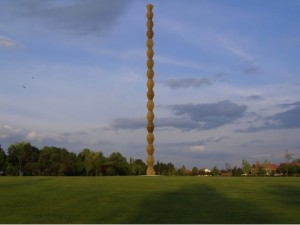
©Mike Masters Attribution-ShareAlike 3.0 Romania (CC BY-SA 3.0 RO) (Creative Commons)
April 18 is the International Day for Monuments and Sites, a day when we remember and celebrate the places that mean the most to us. This year's theme is commemorative monuments. Many of our monuments were built to commemorate an event or to memorialize the builder. From the pyramids at Giza to statues of Stalin and Lenin, these monuments can have very charged political meanings within a moment in time, but also tend to take on new meanings as time passes. Today we may value these places for reasons that have nothing to do with why they were built.
An astonishing commemorative monument in this context is Brancusi's Endless Column ensemble in the small town of Târgu Jiu, Romania, which is today hailed as one of the greatest works of twentieth-century public art. The sculptural ensemble was born as the commission of a sculpture by the National League of Gorj Women. They had in mind a classic World War I commemoration of the decisive battle for Romanian independence that was fought in the town, defending a bridge across the River Jiu. Originally they offered the commission to a local sculptor, Militsa Petrascu, who had recently completed another commemorative work in the town. With remarkable candor, he told them he was not up to the task, and suggested Brancusi. We can only thank him for this act of modesty.
Brancusi was living in Paris, but had been born and raised in the nearby town of Hobita. He promptly accepted the commission. It gave him an opportunity to execute on a large scale a theme that he had worked with over many years -- the "endless column." Brancusi carved several endless columns in wood starting in 1917. The earliest of them is in the Museum of Modern Art in New York, and others can be found in his studio, now conserved as it was left when he died in the Pompidou Center in Paris. The columns were based on a local style of house post in Romania, which Brancusi transformed into an enigmatic and spiritual symbol, brimming with energy. Brancusi described the form as "art imitating nature."
Brancusi planned a monumental column for Târgu Jiu as a symbol of heavenly ascension after death. He carved one module in wood, standing more than six feet high, then proposed that a string of 16 of these modules, cast in metal, would stand end on end, ascending into the sky. As the site of the column, he chose a former hay market standing on a hill above the town. With the help of an engineer, Stefan Georgescu-Gorjan, an ingenious spine was fabricated to hold the modules of the column, which stand upright, one on top of the other, held by the force of gravity. The Endless Column, an artistic and engineering tour de force, was dedicated as the clouds of war were once more gathering over Europe, in 1938.
By then, Brancusi, Gorjan and the patroness Aretie Tatarescu had conceived an even greater scheme. On the site of the battle of Târgu Jiu, Brancusi created a place of contemplation, the Table of Silence. To link it to the town, he built a triumphal arch, the Gate of the Kiss. To reach the Endless Column from the memorial site, you traversed the town from the river's edge, walking through the neighborhoods where the young fallen soldiers had lived, to the hill. He called this the Way of the Heroes.
Although Brancusi had ambitious dreams for public art ensembles around the world, only the one in Târgu Jiu was executed. Developed through improvisation and serendipity, the ensemble can today be read in a variety of ways. It is the nexus of town life; it remains a commemoration of a now obscure event. But for the contemplative visitor, the constant play of light and shadow over the sculptures' forms can be understood as a magnificent metaphor for the passing days and nights of a person's life, from the ritual feasting table, through the portal of maturity to the column of eternity -- a celebration of life itself.
Follow Bonnie Burnham on Twitter: www.twitter.com/@WorldMonuments
'Breasts Too Large' On Bust Of Romania's Former First Lady Arethia Tatarescu, Ministry Of Culture Says
The Huffington Post UK | Posted: 21/04/2014 10:27 BST | Updated: 21/04/2014 10:59 BST
A new bust sculpted to commemorate the wife of a Romanian president must be reworked because its breasts are too large, the country's Ministry of Culture has insisted.
Central European News reported that the sculpture of Arethia Tatarescu has drawn astonished looks after it was unveiled in the local park of her home town of Targu-Jiu.
Pompiliu Ciolacu, head of the local council's Culture Department, said: "Artistically it’s exaggerated, and that means that aesthetically it doesn’t resemble the real image of the person".
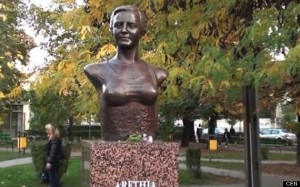
A bust to commemorate the wife of a former Romanian president in her hometown of Targu-Jiu
Radu Boroianu, a deputy minister in the Romanian Ministry of Culture and a modern art enthusiast, called for the sculpture to be taken down and reworked by local artist Paul Popescu.
Gorj County Council had paid more than £4,000 for the work.
But Popescu has refused, calling it a "totally arbitrary reason and at the end of the day in artwork breast size is a matter of taste. We don’t all have to like the same type of women, the same way that not every woman likes the same type of man.
"Minister Boroianu personally finds it too sexy because the breasts are too large. I don't think that the breasts are too small, and I don't think that they are too large. I think they are just right."
Tatarescu, who was born in the city in 1889, and after studying art in Belgium, married the man who was to become prime minister, Gheorghe Tatarescu.
Known for her beauty and refinement, she is rarely pictured wearing anything less demure than a starched blazer and knee-length skirt.
-
- March 29, 2014 - 10:58 am
- Latvia, WWII
- Comments Off on Latvian Petition Challenges Soviet War Memorial in Riga
Russia's Itar-Tass news agency reports on renewed challenges to the Soviet WWII monument in Riga, Latvia, in the wake of Russia's takeover of Crimea and increasing rhetoric about protecting the interests of Russian co-ethnics in the Baltics and other countries of the former Soviet Union. Please see the complete story for a video of the statue and related links.
Latvian parliament has no right to decide fate of Riga Soviet memorial
October 28, 16:57 UTC+4
RIGA, October 28 (Itar-Tass) - The memorial to Soviet Liberators of Riga is under Riga city council's supervision so the Sejm, Latvia’s parliament, has no right to decide its fate, Riga’s first mayor of Russian descent, Nils Ušakovs, said in an interview with LNT television channel on Monday.
“I am not quite sure the Sejm can make any decision about this monument as it is municipal property. The issues of its erection, name and demolition are to be resolved solely by the municipality,” he said. Parliament may send the municipality a letter with recommendations that will be taken into consideration.
Ušakovs pointed to the latest poll commissioned by Riga city council that has shown the overwhelming majority of Riga citizens opposed the demolition. He said their opinion was the main thing to guide him while working in the municipality. “Another poll may be conducted for confirmation,” he added.
A Latvian web portal has gathered more than 11,000 signatures in favour of the memorial's demolition. According to Latvian law, an initiative that has gathered no less than 10,000 signatures of full-aged citizens of the republic is deemed a “collective statement” and is to be considered by Latvia’s parliament, the Sejm.
In response, a counter-motion was initiated for leaving the monument intact. It has gained almost 7,500 supporters so far.
Riga memorial is the main monument for a local Russian-speaking community comprising about 40 percent of Latvia’s population. About 200,000 people gather near the memorial every year to lay flowers and congratulate war veterans. Local nationalists have repeatedly called for demolition of the edifice, erected in the 1980s, though parliament rejected the initiative. The monument has been desecrated several times and even suffered an attempt to blow it up in 1997.
-
For many Czechs, Russia’s Crimean land-grab is strongly reminiscent of the two pivotal times in their own 20th century history during which Czechoslovakian territorial integrity was trampled upon. Although defacing Soviet era monuments (the ones that have not been removed) is fairly common practice in the Czech Republic, the defacers have been extra active this year. And they’ve gotten something fresh and new to have a go at: apparently an organization of Russian veterans from the Afghan war, in commemoration of the 25th anniversary of the start of that war, has erected a monument in Prague’s Olšany cemetery honoring ‘Russian Internationalists’ – soldiers that offered ‘brotherly help’ in countries neighboring the Soviet Union.
As could have been expected, this gesture was not widely appreciated, especially not against the backdrop of the invasion of Crimea. So first someone made the monument into a diorama, with little toy tanks and toy soldiers. Someone also spray painted ‘CZ’ on the monument.

(c) Lidové Noviny. See how the little soldiers were painted red?
Only a few days later, a new addition was made to the monument when a person or persons unknown spray painted ‘Jan Palach’ on the monument, adding a cross (link to LN story).

(c) Lidové Noviny. Note how the CH in Palach is written on one line – not because they ran out of space but because CH is its own letter in the Czech alfabet (it comes between H and I).
Apparently the officials that authorized this monuments only looked at the ‘technical parameters’ of the monument and not at the text which refers to the soldiers as ‘peacemakers’ (in Russian, the Czech on the sign is more neutral about the soldiers). The second Lidové Noviny article notes that although official Russian sources claim 12 ‘peacemakers’ died during the 1968 invasion at the hands of ‘counterrevolutionaries’, domestic historians dispute this…
-
- March 7, 2014 - 8:09 pm
- Lenin, Ukraine
- Comments Off on More From Ukraine
The destruction and alteration of monuments - particularly to Lenin - that began on the Maidan in Kyiv continues to spread to other Ukrainian cities. Here is an angry Russia Today article about a monument to Soviet Field Marshall Kutuzov being pulled down in the Western Ukrainian town of Brody.
Even more interesting, though, is an interactive, regularly updated map showing cities and dates in Ukraine where Lenin statues fell, squares were renamed, etc., called Good Bye Lenin - The Desovietization of Ukraine.
-
Sofia, Bulgaria's Soviet Army memorial, which is often (and often approvingly) vandalized - the soldiers have, for example, been painted as superheroes and in honor of Pussy Riot - was painted again yesterday in the colors of the Ukrainian flag, with writing at the base saying "Slava Ukraini!" and "Ka-putin." Check this link for a short news story (in Bulgarian) and photos, as well as this link for information in English.

And an interesting coda from RIA Novosti - - -
Russia Slams Euronews Over Photo of Vandalized WWII Statue
12:00 25/02/2014
MOSCOW, February 25 (RIA Novosti) – Euronews television channel swiftly pulled a picture of a vandalized Soviet-era military memorial from the head of its Facebook page Tuesday in the latest incident to highlight heightened Russian sensitivity over perceived disrespect for World War II monuments.
The French-based channel, which was set up by the European Broadcasting Union, of which Russia is a member, on Monday posted the Reuters news agency photograph showing a monument of Soviet soldiers in Bulgaria’s capital, Sofia, that had been illegally daubed in yellow and blue paint.
The vandalistic act appeared to be a tribute to an anti-government uprising that last week led to the toppling of the Moscow-friendly president in Ukraine, whose national flag is composed of those colors.
Euronews’ decision to make the photograph of the painted soldier its Facebook cover photo drew swift criticism from Russia’s Foreign Ministry, which had already appealed to Bulgarian authorities to investigate the attack on the statue.
A Foreign Ministry statement said Euronews had “crossed a line” by using the picture.
After hastily changing the cover photo, Euronews said in a statement that the image “was in no way an expression of support for one side or another in Ukraine, not to mention an act of vandalism.”
The photograph simply reflected current events in the world, the channel said.
Russia has condemned the unrest in Ukraine, describing it as the work of violent extremists intent on seizing power.
Earlier this month, US news channel CNN was pressured into issuing a formal apology for including a Soviet war memorial in Belarus on an irreverent list of the world’s ugliest monuments.

© Account Euronews in Facebook
Russia Slams Euronews Over Photo of Vandalized WWII Statue
Russia’s Foreign Ministry said the list had “defiled the memory of those who died in the war against Nazism.”
The Soviet Union’s role in the Allied victory in World War II is heavily relied on by Russian authorities to instill a sense of pride and patriotism among the population, with ever bigger anniversary parades and ceremonies.
Last year, parliamentary deputies considered a bill making it illegal to criticize the actions of the Red Army during World War II. Despite the fervor of sentiments aroused by the issue, the legislation was not adopted.
In 2007, one person was killed and several more injured in riots in the Estonian capital Tallinn over plans to move a statue of a Red Army soldier from the center to a cemetery outside the city.
The statue’s move, which many interpreted as an intended slight against the Baltic nation’s sizable ethnic Russian minority, soured diplomatic relations between the two nations for several years.
-
- February 21, 2014 - 10:01 am
- Hungary, New monument, WWII
- Comments Off on Hungary Postpones Erecting New WWII Monument
Facing widespread complaints that a proposed new WWII memorial commemorating the German occupation of Hungary in 1944 would whitewash Hungary's history of home-grown fascism, the ruling Fidesz government has decided to postpone erecting the monument until after April 6 elections. For more information, see the following news reports:
http://stream.wsj.com/story/latest-headlines/SS-2-63399/SS-2-461213/
http://www.bbj.hu/politics/wwii-memorial-postponed;-pm-offers-dialogue_76100
http://ca.reuters.com/article/topNews/idCABREA1J1LS20140220?sp=true
-
Two articles discussing the latest interest in - and failure to - return Dzerzhinskii's statue to Lubianka Square in Moscow, courtesy of Johnson's Russia List:
Awesome Soviet era symbol keeps Russian society split in two
By Lyudmila Alexandrova
MOSCOW, February 11. /ITAR-TASS/. Lenin called that man, son of an impoverished Polish noble, "a proletarian Jacobean", and put him in charge of fighting counter-revolution. Felix Dzerzhinsky was appointed first head of the All-Russia Extraordinary Commission to Combat Counter-revolution and Sabotage, reorganized into the State Political Directorate - a section of the NKVD (People's Commissariat of Internal Affairs - the then Soviet equivalent of the Interior Ministry) in 1922. Described by his Bolshevist comrades as the "Iron Felix", he initiated massive terror and repressions, hostage-taking and other methods to "defend the Revolution".
After an abortive coup against the USSR's first and last president, Mikhail Gorbachev, in August 1991, the first thing jubilant Muscovites did was to remove the monument to Dzerzhinsky off the plinth. This work of famous sculptor Yevgeny Vuchetich, had been in the centre of the square, called after the first KGB chief, in front of the secret service headquarters for decades. A year earlier, months before the breakup of the Soviet Union, a huge stone from the Solovki islands, used in the first Soviet years as a prison for political opponents, had been placed near the Polytechnic Museum. The square itself was renamed to Lubyanka Square.
This gesture, commemorating all victims of political repression, was then perceived as the final farewell to the darkest pages of the Soviet past. Yet now some are eager to bring the monument back to the square again. The issue lists among the twelve questions the Communist Party's Moscow branch referred to the Moscow election commission requesting a citywide referendum. The commission will rule on the feasibility of resolving such issues via a referendum on February 20.
There has also been a personal initiative of a group of individuals, lodged with the Moscow Duma's commission on monumental art, for renovating the monument and returning it to its original place from Muzeon Park, where Dzershinsky's statue can be seen alongside other Soviet era monuments. Interestingly, this is an eighth appeal for the Iron Felix statue's return since 2001. This is rather unlikely to happen, though, since it also requires the government's approval. The statue is a monument of federal importance. But the issue has already provoked heated discussions in the society.
In the meantime, a large-scale program is now on across the country for erecting monuments to some heroes of World War I. The upcoming ones are monuments to Admiral Alexander Kolchak, generals Nikolai Denisov and Anton Denikin, later leaders of the White Guard movement, the Bolshevik's arch foes.
One can only wonder at how Russians are still concerned about the events of almost one hundred years ago - the Revolution and the Civil War. The war between the Reds and the Whites seems to be going on - in many people's minds. Although eliminating monuments of any epoch, however cruel it may have been, is by no means the best possible way to assert justice, some symbolical personalities in Soviet history invariably split the people in two implacable camps. The personalities on top of that list are Lenin, Stalin and Dzerzhinsky.
Each time someone says Lenin's embalmed body now lying inside the Mausoleum in Red Square should be buried, the Communists and their allies stand up in Lenin's defense, whereas the authorities evade the issue for fear of a flare-up of social tensions. Any event, which the liberal community sees as exoneration of Stalin and his policy of repression, causes uproars in the media. Therefore, it is hardly surprising that attempts to bring the monument back have caused such a tumult again. Should we be ashamed of our history, should we demolish or restore monuments?
"If the monument to the Iron Felix comes back, this place will become the scene of an open-ended rally against it, and I am determined to partake," said Russian human rights ombudsman Vladimir Lukin.
"Dzerzhinsky was simply a butcher of his own people. He executed the Red Terror policy. He has no other achievements in the eyes of our people - if it is to be considered an achievement, of course" believes the head of the Moscow Helsinki Group, Lyudmila Alexeyeva.
"The issue of bringing Felix Dzerzhinsky's monument back to Lubyanka square cannot be viewed from the purely artistic perspective, in terms of the city's appearance, of restoring the square's historical face and so on," a member of the human rights organization Memorial, Oleg Orlov, is quoted by the Novyie Izvestia daily as saying. "One could then indulge in similar speculations about restoring the way some Germany cities looked in the 1930s. Some may say Hitler's monument stood here once, so why not bringing it back irrespective of what we think about this personality? Such reasoning is possible, but it would be absolutely blasphemous and unacceptable."
Yet, some voice other views. The leader of A Just Russia party, former speaker of the upper house of parliament, Sergey Mironov, has spoken in favour of the monument's comeback.
"I think such issues are to be voted on by the people of Moscow in a city referendum, and if I took part in such a voting, I would vote for bringing the monument back," Mironov said. "I am concerned about the fact we have such an easy attitude towards our monuments, we should not be ashamed of our history.
Moscow commission rules not to reinstall monument to Dzerzhinsky on Lubyanskaya Square
MOSCOW. Feb 11 (Interfax) - The Moscow City Duma's monumental art commission unanimously decided on Tuesday not to return a monument to Felix Dzerzhinsky, a prominent Soviet statesman and founder of the Soviet security services, to Lubyanskaya Square in central Moscow.
"Taking into account the current circumstances in society, I propose refraining from returning the monument. This is more of a political issue," Lev Lavrenov, the commission's chairman, said at the Tuesday session.
The commission has considered the return of the monument to Dzerzhinsky to Lubyanskaya Square for the sixth time since 2000.
"We are firmly convinced that it is inappropriate to erect a monument to Dzerzhinsky on Lubyanskaya Square, as it could produce undesirable tensions in society," Lavrenov said.
A number of commission members noted that the monument to Dzerzhinsky, which used to be located on Lubyanskaya Square in Soviet times, is good artwork, and the place where it is located now, the Muzeon park, is best.
Some commission members suggested during the discussions that the monument could be returned in the future, while others objected to this in principle.
"When those who don't remember this man come several generations later, they might reinstall [the monument]. Vladimir Ilyich [Lenin] and Dzerzhinsky started the repression," commission member Valery Perfilyev said at the session.
Officials from the Moscow city culture department and Moscow City Architecture Committee also noted that it would be inappropriate to reinstall the monument now.
The monument to Dzerzhinsky was transferred from federal to municipal ownership in 2008 and is officially considered a cultural heritage object. Its condition has been found to be unsatisfactory, and its restoration is planned in 2014.
Two individuals known as Zilinsky and Terekhov had earlier filed petitions on reinstalling the monument on Lubyanskaya Square. The commission is supposed to consider any incoming proposals on installing monuments.
-
How did I miss this one back in October? Note the involvement of both the Russian government and the Russian Orthodox Church - - -
Muscovite Builds Record-Breaking Jesus Statue in Syria
Moscow Times, 23 October 2013 | Issue 5240

Pravoslavie.ru
The statue is even taller than the famous Christ the Redeemer in Brazil.
A bronze statue of Jesus Christ, taller than the famous Christ the Redeemer statue in Rio de Janeiro, has appeared in war-torn Syria.
The statue, titled "I Have Come to Save the World" was apparently the brainchild of Yury Gavrilov, a 49-year-old Muscovite who runs an organization in London called the St. Paul and St. George Foundation.
The project was backed by both the Russian Orthodox Church and the Russian government, which takes an active interest in Syria, as seen in recent events. Russia also has a navy base on Syria's Mediterranean sea coast.
Despite the statue's Russian connection, it was cast in Armenia and made by an Armenian sculptor, Artush Papoian. Syria's ethnic Armenians have been fleeing the country in droves since the conflict began, to the extent that Armenia has built a new settlement called New Aleppo to house them, the news website Eurasianet.org reported. The settlement is named after the war-torn northern Syrian city where most of Syria's ethnic Armenian population live. Some 7,000 of Syria's ethnic Armenians are now seeking refuge in neighboring Armenia, Armenian news agencies reported.
The Armenian statue was installed Oct. 14, which coincided with two religious holidays — both Orthodox Christian and Muslim. Orthodox Christians celebrate the feast day of the Protection of the Most Holy Virgin Mary and Muslims celebrate Kurban Bayram.
Though all military activity was suspended in the region while the statue was being installed, the project has been in the works since 2005 and is not related to the current military crisis in the country, Komsomolskaya Pravda reported.
The statue is located on a mountaintop near the city of Saidnaya. The statue is near the Monastery of the Cherubim, perched above the historic pilgrimage route from Constantinople to Jerusalem and is 2,100 meters above sea level.
The statue stands at 39 meters tall together with the plinth, which is taller than Rio de Janeiro's Christ the Redeemer statue, which stands at 38 meters. The enormous statue can be seen from neighboring countries Lebanon, Jordan, Palestine and Israel.
The director of Gavrilov's St. Paul and St. George Foundation, Samir el-Gadban, commented on the importance of the statue in the war-torn country and expressed his hopes for the future.
''We hope that this sculptural composition brings peace and love to the hearts of people and that our work will help restore peace and calm in this long-suffering region,'' he told Komsomolskaya Pravda.
Read more: http://www.themoscowtimes.com/arts_n_ideas/article/muscovite-builds-record-breaking-jesus-statue-in-syria/488312.html#ixzz2qfJmd5UC
The Moscow Times
-
Ben and I have written a few times on Russia's "missing memorial" - that is, a proper national memorial to the victims of the gulag and Soviet terror. Although the initial intent was for Memorial's Solovetskii stone on Lubyanka square to be an initial marker for a larger, government-sponsored memorial-to-come - perhaps in the square's center, where secret police founder Dzerzhinsky used to stand - government interest in the project waned after the Soviet collapse. Below is the latest Western newspaper article noticing this long-time omission.
The Spectator (UK)
January 4, 2014
Why doesn't Russia have a Yad Vashem for the gulag?
One of the 20th century's great crimes is still awaiting a fitting memorial
By Mary Dejevsky
Yad Vashem, Israel's vast Holocaust memorial complex, dominates a hillside above Jerusalem, surrounded by bare rock and pines. Vast though it is, it manages to be both harrowing and restrained; both rooted in the times it commemorates and thoroughly modern not just in style, but in the way it harnesses the most advanced technology to its cause.
As an enterprise, let alone a monument, it is impressive: a testament to the commitment of Israel and the survivors of Europe's Jewry to ensure that what happened is never forgotten. But it aspires to more: to convey a sense of the communities that were destroyed and to memorialise, so far as possible, every last individual. The idea is to humanise those who had been stripped of their humanity: to establish each victim's identity, to name every name.
To date, the archive at Yad Vashem has four and a half million names, many with dates of birth and death, even photographs. Two thirds of its holdings have been digitised and are available worldwide. No one accepts that the task is anything like complete.
The new museum at the centre of the complex is a model of what a modern museum can be. By the age of 25, practically every Israeli will have taken part in several group visits as a pupil and as a military conscript. Such exposure to the catastrophe of the last century helps form the outlook of every citizen of Israel.
Contrast this with the Museum of the Gulag I chanced upon in Moscow a couple of years ago, its presence indicated only by a handwritten sign. Sparsely staffed by elderly volunteers and comprising just a few rooms, it was heroic proof of personal dedication. There was a faithful reconstruction of camp accommodation; fragments of letters and diaries, official documents authorising banishment or rehabilitation; the wooden spoons and food tins that have become, in their simplicity, icons of life in the Gulag.
It would be wrong to accuse post-Soviet Russia of doing nothing to remember the victims of communism. The works of Solzhenitsyn, including The Gulag Archipelago, are now prescribed reading in Russian schools. As President, Vladimir Putin yes, even Putin has spoken at gatherings to commemorate victims of Stalin's purges. The 30th of October is designated the day of remembrance of political repressions. Local newspapers, and now websites, have regular features publishing appeals from people trying to trace missing friends and relatives.
And the admirable organisation, Memorial, works to identify burial sites and establish the fate of the missing. In 1990, it placed a monument a huge boulder from the prison complex in the Solovetsky Islands in front of the notorious Lubyanka in Moscow. But Memorial is a non-governmental organisation, and commemoration depends, all too often, on individual initiative.
It could justly be argued that integrating such a painful past takes time. Although the law establishing Yad Vashem was passed just five years after the foundation of the state of Israel, the project advanced only by stages and not without controversy into the extensive complex that exists today. There is a crucial difference, too, between the situation of Russia and Israel. As has been said epigrammatically: half of Russia did time in the camps; the other half sent them there. There is as yet no agreement on a common past.
But more than 20 years have elapsed since the collapse of the Soviet Union, and the number of those who passed through the country's prison camp system is estimated at between 15 and 50 million. Is it not time for today's Russians, and the Russian state in their name, to start incorporating that past trauma into their present? Regrettably, there is little evidence that this is happening.
Take Memorial. The bulk of its funding comes from Germany. It is not only the state that has denied funding; Russia's oligarchs, it seems, would rather spend their wealth on foreign football teams, Fabergé eggs or English public school fees for their offspring. Contrast this with the long list of eminent Jews who helped fund Yad Vashem.
It is not just Russia, of course, that could usefully take the Holocaust memorial as a blueprint for commemorating a tragic past in a credible and modern way. Rwanda is one of the latest countries to ask Yad Vashem for advice on compiling an archive to remember its ugly recent history. But the scale of Israel's project as it was conceived, the spirit in which the 700 or so staff work there, and their determination to continue until each and every victim has a name, all offer Russia a model of how it might proceed. For it is only when the state and its citizens restore the memory of their past, that Russia will become a fully normal country.
-
- January 3, 2014 - 3:21 pm
- Georgia, Stalin
- Comments Off on Stalin (not) in Telavi
TBILISI, December 31 (RIA Novosti) – A statue of Soviet leader Josef Stalin was demolished on Tuesday in the eastern Georgian city of Telavi months after being vandalized, local media said. The three-meter-high statue, part of a World War II memorial, was commissioned by the local Stalinets social group and the Union of Veterans in September, but was vandalized with red paint hours after being unveiled. The vandals also wrote “Murderer,” “Down with Stalinism!” and swear words on a nearby wall. The city municipality denied issuing any permission to install the statue and ordered it to be removed within five days. Activists said they were not going to comply with the administration’s order and announced the start of a campaign to collect signatures in support of the statue. The authorities had to allocate about $400 from the city budget to eventually tear the monument down. Stalin evokes mixed memories in Russia and other former Soviet republics, particularly in his native Georgia. While being credited with leading Russia to victory in World War II and strengthening the country, he is also remembered for sending millions of people to death in concentration camps during the infamous purges of the 1930s, and for carrying out particularly savage repressions in the Caucasus, including Georgia.
and . . .
RFE/RL, December 31, 2013
A monument to Soviet dictator Josef Stalin has been removed in the eastern Georgian city of Telavi. Police were present during the monument's removal on December 31. Telavi authorities say the monument was placed near a World War II veterans' memorial in Telavi without official permission. The monument has been vandalized several times since it was first unveiled on September 1. It was made with money collected by the nongovernmental organization Stalinist and the Union of Georgia's Veterans. Stalinist's leader, Shota Lazariashvili, condemned the monument's removal, calling the authorities' decision "a shame." Telavi is about 110 kilometers from Stalin's birthplace, Gori, in central Georgia.
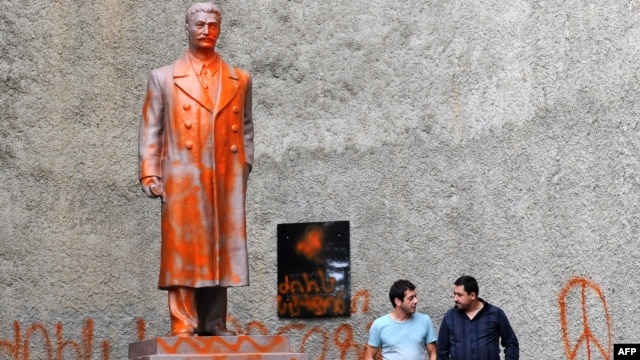
Copyright (c) 2012. RFE/RL, Inc. Reprinted with the permission of Radio Free Europe/Radio Liberty, 1201 Connecticut Ave., N.W. Washington DC 20036.
-
- December 22, 2013 - 9:39 pm
- Georgia, Stalin
- Comments Off on Stalin in Georgia
Stalin's birthday, December 21, 2013, has come and gone, and still no sign of the promised new Stalin statue:
RFE/RL, July 30, 2013
Georgia To Restore Monument In Stalin Birthplace
Georgia's Culture Ministry has announced that a monument to Josef Stalin will be restored in the late Soviet dictator's birthplace. The ministry's spokeswoman, Elena Samkharadze, said on July 30 that the monument in Gori will be restored by December 21, Stalin's birthdate. The monument was torn down amid a crackdown on Soviet-era monuments by pro-Western President Mikheil Saakashvili in 2010.
Saakashvili's presidential term does not end until October, but his authority has been further weakened by a constitutional reform that has shifted powers from the presidency to parliament and new Prime Minister Bidzina Ivanishvili. Speaking on July 30, Saakashvili said the move is anti-Georgian and barbaric and he is "outraged with it."
The 6-meter bronze monument to Stalin is currently lying on the ground at a Georgian Defense Ministry military base in Gori. A spokesperson for the ministry told reporters that the statue will not be returned to its original pedestal in Gori's central square but will be erected at the town's Stalin Museum.
Based on reporting by AP and Interfax
Radio Free Europe/Radio Liberty © 2013 RFE/RL, Inc. All Rights Reserved.
So, instead, let's catch up on Stalin-related events in 2012, before our website went up . . .
From Reuters:
Georgian village reinstates Stalin monument to mark anniversary
Fri, Dec 21 2012
By Margarita Antidze and David Mdzinarishvili
ZEMO ALVANI, Georgia (Reuters) - Residents of a mountainous village in the former Soviet republic of Georgia reinstated a monument to dictator Josef Stalin on Friday to mark the 133rd birthday anniversary of their famous compatriot.
Some 30 residents of the village of Zemo Alvani, 200 kilometers (124 miles) north-east of the capital Tbilisi, gathered to witness the unveiling of the three-meter-high stone statue of Stalin.
The statue was removed a year ago by local authorities after President Mikheil Saakashvili said the late dictator was too closely associated with what he called the "Soviet occupation of Georgia" and called for memorials to Stalin to be dismantled.
"I came here because I love Stalin and I love my people ... I remember when I was 12 how my grandmother was weeping when Stalin died," said Phatima Patishvili, a Zemo Alvani resident.
The monument's reinstatement is a sign that Stalin's personality cult is still alive across the former Soviet Union where supporters credit him with the Soviet victory over Nazi Germany during World War Two and with turning the country into a superpower.
However, for many Georgians, including for pro-Western President Saakashvili, the few remaining monuments to Stalin are an unwelcome reminder of Moscow's lingering influence in Georgia two decades after the small nation gained independence following the 1991 collapse of the Soviet Union.
Resentment of Russia flared in Georgia when the two fought a brief war in August 2008.
Saakashvili and others also believe it is wrong to still venerate a man who oversaw the purges, the Gulag prison camp system and man-made famines that killed millions.
Georgia's former government, then led by Saakashvili allies, removed another Stalin monument in 2010 - a 6-metre-high bronze statue in the dictator's native town of Gori.
The authorities were planning to replace it with a monument to victims of Stalin's purges and to those of the 2008 five-day war, but the project was never implemented.
Georgia's new government of billionaire Bidzina Ivanishvili wants to improve ties with Russia. It said it did not oppose the reinstatement of the Stalin monument in Zemo Alvani.
It also said it would finance the restoration of the Stalin monument in Gori, the Georgian city most affected by the 2008 war that saw Moscow recognize the two breakaway regions of Abkhazia and South Ossetia as independent states.
Russian President Vladimir Putin said on Thursday that Russia would not reverse its decision.
A coalition led by Ivanishvili, who made his fortune in Russia, won Georgia's October 1 parliamentary election ending a long period of political domination by Saakashvili, who first rose to power as leader of the 2003 "rose" revolution.
(Writing by Margarita Antidze; Editing by Gabriela Baczynska and Andrew Osborn)
AND THEN . . .
RFE/RL, September 02, 2013
Vandals Damage New Stalin Monument
A new monument to Soviet dictator Josef Stalin in Georgia has been vandalized hours after it was unveiled.Unknown individuals overnight poured orange paint on the 2-meter statue in the town of Telavi, some 100 kilometers from the capital, Tbilisi.It was erected and unveiled on September 1 by a local Stalin society next to a monument dedicated to soldiers who died during World War II.
In December, to mark the 134th anniversary of Stalin's birth, his hometown of Gori plans to reerect a statue that was removed by the government of President Mikheil Saakashvili in 2010.
Saakashvili led a campaign against monuments to the Georgia-born dictator, saying the country could not simultaneously host a museum for victims of Soviet occupation and monuments honoring those who carried out that occupation.
Based on reporting by Apsny.ge and Lenta.ru
Radio Free Europe/Radio Liberty © 2013 RFE/RL, Inc. All Rights Reserved.
-
- December 22, 2013 - 8:31 pm
- Lenin, Ukraine
- Comments Off on Lenin Falls in Kyiv
On the night of Sunday, December 8, pro-EU demonstrators on the Maidan pulled down Kyiv's most prominent remaining statue of Lenin, an imposing statue that had remained standing since the collapse of the Soviet Union. Below we have gathered photos, links to articles, and other information about this remarkable event:
Here's a photo of the original statue a few years ago:

Photo: Spyridon Kotsovilis
Here is a link to the full-length YouTube video of the statue being destroyed - amazing!
Here's a photo of the statue being destroyed:

Photo: The Atlantic
Here are photos of the aftermath:
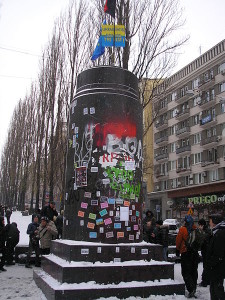
Photo: BaseSat, Wiki Commons, 9 Dec 2013

Photo: Maria Popova, 14 Dec 2013
Maria's comments on the photo below: "This is the pedestal of what used to be Lenin's monument in Kyiv. The Russian-language stickers are probably targeted at those who come to mourn, rather than celebrate Lenin's toppling. One says: "it [maidan] is not for Europe-- it's against corruption. Come to Maidan"
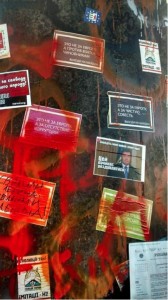
Photo: Maria Popova, 14 Dec 2013
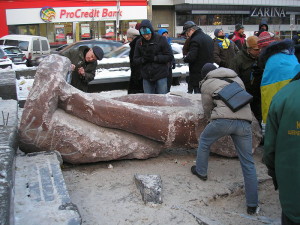
Photo: BaseSat, Wiki Commons, 10-Dec-2013
Oxana Shevel posted the photo below, with a translation of the joke: "Dear Nadia (Lenin's wife's name), I left to support the revolution. Your Vladimir"

Photo: Posted by Oxana Shevel
Here are the relevant parts of the New York Times article on December 8, breaking the news:
http://www.nytimes.com/2013/12/09/world/europe/kiev-teems-with-pro-europe-protesters-as-thousands-more-gather.html?hp&_r=1&
December 8, 2013
Protesters in Kiev Topple Lenin Statue as Rallies Grow
By DAVID M. HERSZENHORN and ANDREW E. KRAMER
KIEV, Ukraine — Public protests thundered into a full-throttle civil uprising in Ukraine on Sunday, as hundreds of thousands of protesters answered President Viktor F. Yanukovich’s dismissiveness with their biggest rally so far, demanding that he and his government resign. At the height of the unrest on Sunday night, a seething crowd toppled and smashed a statue of Lenin, the most prominent monument to the Communist leader in Kiev. The act was heavy with symbolism, underscoring the protesters’ rage at Russia over its role in the events that first prompted the protests: Mr. Yanukovich’s abrupt refusal to sign sweeping political and free-trade agreements with the European Union. . . . Later, as the Lenin statue was pulled down and men took turns splintering it to bits with a sledgehammer, protesters twice sang the national anthem, removing their caps and covering their hearts with their hands. One of the hammerers wore his hair in a mohawk; another was a priest in black vestments. Onlookers shielded their faces from the flying granite chips as they cheered them on, yelling: “Good job, guys.” A spokesman for Prime Minister Mykola Azarov called the statue’s destruction “barbaric.” . . .
The Atlantic's Uri Friedman has written the best story so far in English putting the statue in its historical context. I've pasted a few teaser paragraphs below; please go to the Atlantic's website to see the full article plus photos and videos:
http://www.theatlantic.com/international/archive/2013/12/the-remarkable-history-behind-ukraines-toppled-lenin-statue/282141/
The Remarkable History Behind Ukraine's Toppled Lenin Statue
In the largest demonstrations since the country's Orange Revolution, protesters tore down the symbol of Soviet influence.
Uri Friedman Dec 8 2013, 9:36 PM ET
There are many ways to create iconic moments during protest movements, but perhaps none is as reliable—as fraught with symbolism—as toppling a statue.
On Sunday, as hundreds of thousands of Ukrainians took to the streets of Kiev in the largest anti-government demonstrations since the country's 2004 Orange Revolution, protesters did just that—tearing down an 11-foot-high statue of Bolshevik leader Vladimir Lenin with a steel wire, smashing the monument with sledgehammers, and then carrying off prized pieces of the sculpture.
The massive "Euromaidan" protests, which have been roiling Ukraine since President Viktor Yanukovych rejected an EU trade deal in late November in an apparent effort to move the country away from Europe and toward Russia, are led in part by the right-wing, nationalist Svoboda party, which gleefully reported its involvement in the toppling of the Lenin statue (predictably, members of the country's Communist Party are fuming about the incident).
The statue, it turns out, has a remarkable history—and not just as a locus of protest during the latest wave of demonstrations in Ukraine. The monument was first created by the Soviet sculptor Sergey Merkurov, a man famous for making a plaster "death mask" of Lenin on the night he passed away, for a Soviet exhibition at New York City's World's Fair in 1939 (see the postcard on left). And it was hastily imported to the Ukrainian capital in 1946 when, as one BBC account puts it, local authorities suddenly realized "that unlike all the other Soviet republic's capitals, Kiev had mysteriously remained Lenin-free." . . . .
Meanwhile, other Ukrainian Lenins have also suffered the consequences:
Lenin Statue Toppled, Reinstated in Ukraine
KIEV, December 30 (RIA Novosti) A statue to Russian revolutionary leader Vladimir Lenin was toppled in the central Ukrainian town of Vatutino on Sunday night only to be put back in place several hours later, the UNIAN news agency reported Monday.
"A group of unidentified persons detached the monument from the pedestal and toppled it. But it turned out that the statue, made of plaster and bricks, was solid enough to sustain the fall. Only the back of Lenin's head and his cheek were slightly damaged," the agency said.
Municipal workers put the statue back in its place on Monday morning and fixed it there with a layer of concrete.
A number of Lenin statues across the country have been vandalized since early December amid ongoing protests against the government's decision to halt a landmark political and free-trade deal with the European Union and, instead, opt for stronger ties with Russia.
The first and most notable act of vandalism took place in the capital, Kiev, on December 8, when a landmark statue of the founder of the Soviet Union was torn down by pro-European protesters in symbolic defiance of Russian influence.
Hours later, another statue of the Soviet leader was vandalized in the southern town of Kotovsk.
With ramifications as far away as Vietnam:
http://www.bbc.co.uk/news/world-asia-25314583
10 December 2013 Last updated at 10:46 ET
How Lenin's statue in Ukraine silenced news in Vietnam
By Quynh Le BBC Vietnamese
As Lenin's statue was toppled in Kiev, the authorities in Vietnam developed cold feet
As protesters gathered in the Ukrainian capital Kiev in late November, the authorities in Vietnam probably gave little thought to a story unfolding thousands of miles away. The blockade by protesters angry at a government U-turn on a free trade deal with the EU was widely covered in the Vietnamese press and proved a popular subject on social media. But everything changed in Vietnam when the statue of Vladimir Lenin came crashing down in Kiev. On Sunday a group of protesters smashed and dismembered the city's statue of the Russian revolutionary leader. Transgression too far?As was to be expected, the news was quickly and widely reported on all major websites in Vietnam. On the BBC Vietnamese website, it went straight to the most read spot, proving even more popular than coverage of the death of Mandela and protests in Thailand. But within 24 hours, all that changed in Vietnam - there was soon no trace to be found of articles mentioning the toppling of Lenin. State media coverage of Ukraine's continuing unrest was subdued. The most plausible explanation - say many analysts - is that the toppling of the statue of the revolutionary struck a nerve in Vietnam's Communist government.

Vietnam's own statue of Lenin has pride of place in a park in central Hanoi
Where previously authorities saw little harm in fairly neutral coverage of a country so far away, the fate of the carved and polished red Labrodorite Lenin was a transgression too far and they suddenly developed cold feet. The Soviet leader is still revered by the ruling Communist Party in Vietnam, where his birthday is still celebrated each year. It may well have been an unwelcome reminder of countless statues of Lenin and other Soviet leaders being brought down as the former Soviet Union collapsed. Vietnam has its own notable statue. A 5.2m-high (18ft) bronze figure of Vladimir Ilyich Lenin on a 2.7m marble pedestal peers down at passers-by in central Hanoi. The statue was given to Vietnam by the Soviet Union in 1982. It overlooks some of Hanoi's most important sights. Lenin has become very much part of the landscape and few of those strolling through the park he is placed in would give him much thought. The official Vietnam News Agency described those who knocked down the statue as "extremists". Meanwhile, Thanh Nien, a major newspaper in Ho Chi Minh City, said "hundreds of thousands of anti-government protesters" toppled the statue of the founder of the Soviet Union. Its tone of disapproval was similar.
Then the state media machine kicked in. After all, statues of Vietnam's own communist revolutionary leader Ho Chi Minh are also to be found in cities around the country. There was cyber silence in Vietnam as articles were pulled from the websites. On Google, when one clicked on the headlines, one would be notified of "errors" - although many articles could still be found via Google Cache. The BBC was told that editors at some newspapers received "instruction on telephones" from the Ideological Department of the Communist Party, which enforces media censorship and control in Vietnam. But once news came out that the story had been censored, Vietnamese on social media started to become aware of just how sensitive the party was to that particular story. It is actually when the stories disappeared that people began to notice. "Politicians and leaders should learn to face the truth. You cannot hide everything any more," one user wrote on the BBC Vietnamese Facebook page. Indeed, had the authorities not become so fearful of news in Ukraine fuelling dissent in Vietnam, readers may well have glanced over the images of a fallen giant without giving a second thought to the bronze figure standing in Hanoi's Lenin Park.
The BBC also invites you to enjoy Five Lenin Statues in Unexpected Places.
Courtesy of Oxana Shevel, via Twitter, a map of the fallen Lenin statues in Ukraine:
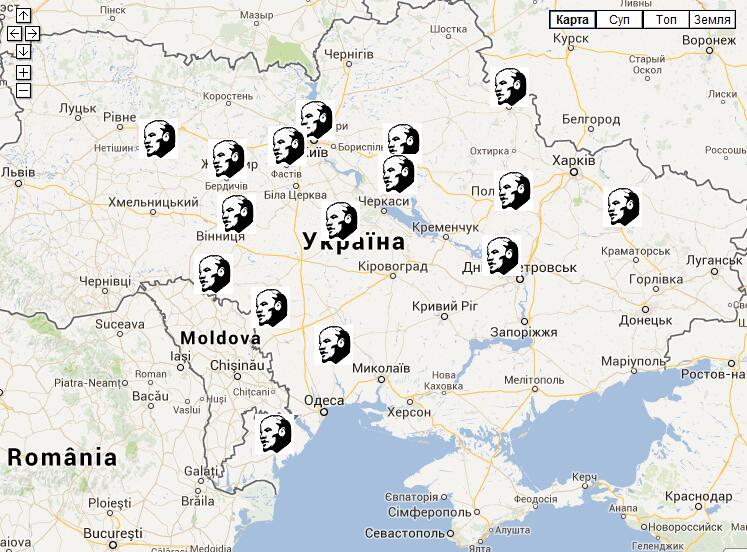
Here's another update, an article from the BBC entitled Ukraine Commits Statuecide.
-
Business New Europe
November 7, 2013
A memorial day few Russians want to remember
Julia Reed in Moscow
"Who was killed in your family?" A man in a beret in his early 60s asked me as he joined the long queue of people. We were both attending the annual recital of the names of the victims of political repressions in Russia by the Solovetsky Stone in Moscow's Lubyanka square, right next to what was the KGB headquarters. This stone was brought from the Solovki Islands in the icy seas off the far northern coast of Russia, where the first Gulag prison camp was opened in 1919. (Bizarrely, the RUB500 bank note pictures the island's monastery.)
I wasn't ready for this question since I somehow assumed that repressions should concern all members of the society and not just the families of the victims. Yet a large number of people in the queue held photographs of their loved ones. The man next to me had a small self-published booklet that contained photocopies of the verdicts and even names of the people who gave evidence or signed the papers that led to his father being executed and his older sister sent to Mordovia, one of the locations of the Gulag prisoner camps (and where until last week Pussy Riot leader Nadezhda Tolokonnikova was being held).
"Last year I waited for three hours," said Arkady Grymov, 62. "It's because many people do not just read out the names they are given (by the members of Memorial, a history preservation society that researches and archives information on repressions in the Soviet Union and about the Gulag system), but they also recite poems, make speeches and add the names of the victims they knew personally."
Indeed, it seemed as if every third person that came to the microphone would call out the names of their family members. Along with each name came the age, occupation and date of the execution. The occupations were strikingly ordinary: worker, shopkeeper, janitor, guard, usher, vet, priest, secretary, low-level government employee. Some of them were junior NKVD (the Soviet secret police in the 1930s and 40s) officers. No famous names or important jobs.
"Perhaps you know somebody?" insisted the same man behind me in the queue. I realized that I could not think of anyone who I was certain was repressed, and this was telling of the environment of secrecy and avoidance that surrounded my Soviet upbringing.
Unwanted history
If you have never heard that October 30 is a memorial day to commemorate the victims of political repressions in Russia, you are not alone. In fact, only a fraction of Russians know. This is not surprising: not only does this date not come up in the top news of the state television channels, it hardly even makes it into the liberal internet news as a newsworthy discussion topic.
Yet just in Moscow there are archived records of 30,000 people killed between 1937-1938. Soviet leader Nikita Khrushchev's landmark speech denouncing Stalin in March 1956 made the fact of repression in the USSR public and gave rise to the process of rehabilitation and release for the victims. The topic became widely publicized and debated again in the 1990s with the collapse of the Soviet Union, when even the ban on the Communist Party was being discussed but rejected by the Constitutional Court.
However, Russia's mass media pay little attention to the subject. It is safe to say that today's Russians have chosen to ignore the darkest days of their history. "My mother told me when I was 15 that my great grandfather was repressed during the war for wanting to build a church in his village, but I never gave it much thought because I was told that it was a regular event for such times," says Natalia Belova, 35.
There are reasons for that. The current political climate does not favour any other view of the Soviet past other than as a period of heroism and dedication by the people. This year on the annual day when members of the public can come to the Solovetsky Stone to remember the victims, the state channels dedicated airtime to Putin giving out awards to distinguished members of society in the Kremlin Palace and to the celebrations of the 90th anniversary of the Komsomol (the youth division of the Communist Party of the USSR).
Soviet history is being rewritten in soft and warm tones, portraying life in the Soviet Union with its normal ups and downs, great enthusiasm and romanticism of large national construction projects involving the youth, with a strong emphasis on the real achievements of the "socialist paradise": the rapid industrialization of the economy, the victory in World War II, and Yuri Gagarin's first flight into space.
Unlike in Germany where there was an official denunciation of Nazism, Stalinism has never been officially denounced. Stalin is still largely perceived as an effective hardliner who won the war and built the nation and is, if not exactly a source of pride, at least not a source of shame either.
Even the families of the repressed continued to join the NKVD and write letters to "Great Comrade Stalin" in those days. The generation who are now in their 60s the sons and daughters of those who lived under Stalin still don't see him as evil; the truth of his crimes and the revelations of this macabre period in the Russian history have not transformed their psyche. "Those who worked for NKVD had no choice, they were just recruited there. If they protested, they would be killed themselves. Such were the times they were also the victims of the regime", says Lyudmila Kozlova, 66.
Today's older generations perceive Stalin as akin to Peter the Great or Napoleon: probably lacking some humane qualities, but a strong-willed patriot who did good things for the country.
Memorial holds tours of the sites in the centre of Moscow that are associated with Soviet terror. None of these places are known to the Russian public and only a few are on tourist maps, like the KGB building (which houses the successor FSB) or the Solovki Islands.
Tours that give an insight into the history of repressions are not routinely conducted in schools, institutions of higher learning or Moscow-awareness tours. What's more, some of these buildings that should have become memorial museums, such as the Military Council of the Supreme Court of the Soviet Union, (where 31,456 people were executed in 1936-1938), have been privatized and turned into offices and commercial property.
Political repressions of today
This year's memorial service at the Solovetsky Stone sparked a little more interest than usual from that small segment of the public concerned with the plight of the more recent political prisoners such as jailed oligarch Mikhail Khodorkovsky, his partner Platon Lebedev, the jailed members of punk rock band Pussy Riot, and the protestors arrested and imprisoned following the clashes with the police during the protests in May last year.
Stalin-style policies of sacrificing individuals for the sake of grand ideas or persecuting those who are seen as different have not only not been denounced, but have taken strong root in the Russian mentality and are silently accepted by the majority. This is seen in the adoption of new laws restricting the freedom of gays, NGOs and in daily treatment of migrants.
Human life continues to have little value in today's Russia, much the same as it was under Stalin, and the judicial and prison systems have experienced little reform since the Gulag times. Prisons are still characterized by harsh, un-dignifying conditions and almost slave labour, as described in a recent letter from a prison in Mordovia by Pussy Riot's Tolokonnikova. Her observations are echoed by many other former inmates of Russia's prisons.
Putin is expected to endorse a new unified version of a Russian history textbook soon. One can only wonder if it is going to be history described from different points of view or continue the trend of emphasizing Russia as a "Great Country" and ignoring the suffering of its people.
"There is no family in Russia who have not been affected by the repressions," says Irina Ostrovskaya of Memorial. Indeed, as I started writing this piece thinking that no one was affected by repressions in my family, I discovered that my great grandfather spent 10 years in jail, was released severely ill and was only rehabilitated in 1991, years after his death.
-
- December 22, 2013 - 7:41 pm
- Turkmenistan
- Comments Off on Turkmenistan's State Of Perpetual Mobilization
For videos and photos, please see original article here.
RFE/RL
October 29, 2013
by Sahra Ghulam Nabi and Charles Recknagel
To watch Turkmen state television is to know no citizens love their president and enjoy regaling him with spectacles more than those of Turkmenistan.
Every month, thousands of people assemble at stadiums or parade grounds to participate in carefully choreographed festivals that celebrate their country and its leader, Gurbanguly Berdymukhammedov.
The official calendar lists 24 national celebrations, ranging from the "Day of Turkmen Workers of Culture and Art" to "Turkmen Melon Day." But there are scores of other mandatory events, such as the "Day Of Neighborliness," which also must be observed in every town and village. In some months, state newspapers have announced as many as 64 occasions to be celebrated during a four-week period.
Government employees and students -- the two most frequently drafted groups for the celebrations -- are left with little free time of their own.
"For the past seven to eight years, because of the mass events and festivals, people who work for the government have forgotten what having time of your own on weekends and holidays is like," says one Turkmen, who identifies himself only as Arslan. "For example, every weekend there is an event, from national bike-riding day to a visit by the president. On such days people wake up at six in the morning [and participate] until around 11 in the evening, when the president leaves again. Everyone has to be on his feet outside, no matter whether it is hot or cold. There is no way for people to keep busy with things they like, such as reading books or relaxing."
Once a person is selected to participate by an office or school committee, the only way to escape a celebration is through a medical exemption. Otherwise, one goes straight into days or weeks of rehearsals in which thousands of people are drilled simultaneously to perform synchronized steps. The steps may range from dance moves to holding up colored cards simultaneously with thousands of other people.
Strict Rules
During the rehearsals -- and the performance itself -- the rules are strict. No water bottles. No food. No talking to those around you.
One student, who only gives her first name, Humay, is a veteran of such rituals.
"I have participated in many of these events," she says. "Generally speaking, they are all unnecessary and no one wants to take part. For example, when there was an independence day celebration [on October 27], it usually was organized in the evening, so we were taken every evening for rehearsals, several days in advance, and had to spend all day out in the cold, just sitting there hungry and thirsty."
The ban on drinking can have dire consequences, especially for children. One student, who gives her name only as Bahar, remembers contracting dysentery after she and her schoolmates quenched their thirst from a public fountain in Ashgabat.
"It used to be extremely difficult in summer times, because we were not given drinking water," she says. "I remember a situation when I was in the fourth grade and we were standing for so many hours without water that when it was over we ran to the nearest public fountain and drank the [unclean] water directly from the pool."
Often participants have to wear clothes that are inappropriate for the weather as they take part in pageants wearing national costumes.
Women may stand in colorful summer dresses in the middle of Turkmenistan's harsh winter and afterward fall seriously ill. Men may wear rustic winter coats and sheepskin hats in the heat of summer and sometimes collapse from dehydration. They must constantly smile at the cameras and an audience of citizens who, themselves, are required to attend.
Such mass celebrations are not new to Turkmenistan. They were fostered by authoritarian President Saparmurat Niyazov -- Berdymukhammedov's predecessor -- who continued the tradition of Soviet state spectacles after the country's independence from Moscow in 1991.
Personality Cult
Niyazov used the celebrations to help create a personality cult that also included mandatory school study of "Rukhnama," his book of personal musings.
But correspondents in Turkmenistan say Berdymukhammedov, who came to power upon Niyazov's death in 2006, favors still more frequent and elaborate public celebrations than his predecessor.
State-run media declared in 2012 that Turkmenistan had entered a new "era of supreme happiness" in the wake of Berdymukhammedov's landslide reelection -- and public celebrations are key to supporting that message.
"There has to be this constant show of success, of prosperity, and of enjoyment of being the nation that you are," says John MacCloud, an expert on Central Asia at the London-based Institute for War and Peace Reporting. "You need intense political pressure to maintain that kind of narrative of a state that is not only wonderful but getting better. We saw it under Stalin in the 1930s, where oppression was matched with these joyous stories and mass ecstasy, and we see the same attempt in North Korea, and we saw it to an extent in [Nicolae] Ceausescu's Romania."
But if the mass celebrations serve the Turkmen government's purpose, they place a heavy burden on the population.
Not only do Turkmen citizens lose their private time to the events, they also must pay out of their own pockets for the costumes many of the celebrations require. Teachers order students to bring money from home for clothes and accoutrements, then turn the money over to state ministries responsible for supplying the goods.
At times, the expenses go far beyond a new three-piece suit for boys or a new national dress for girls -- purchases already burdensome for poorer families. They can also include buying a tree sapling or a new bicycle -- the choice essentially depends on whether the parade one is drafted for is to celebrate National Tree Day or National Bicycling Day.
Written by Charles Recknagel, based on reporting by RFE/RL Turkmen Service correspondent Sahra Ghulam Nabi in Prague
Copyright (c) 2013. RFE/RL, Inc. Reprinted with the permission of Radio Free Europe/Radio Liberty, 1201 Connecticut Ave NW, Ste 400, Washington DC 20036.
-
- December 22, 2013 - 7:39 pm
- Tajikistan
- Comments Off on Tajik tree, symbol of 'eternal independence', dies
Agence France-Presse, August 21, 2013
A 50-year-old tree planted in the centre of Tajikistan's capital Dushanbe by President Emomali Rakhmon this year as a symbol of the ex-Soviet state's "eternal independence" has dried up and died.
The coniferous sequoia, reportedly imported from the United States and planted by Rakhmon at a ceremony in March outside the foreign ministry, died as a result of dehydration.
The tree, of a type which can live for up to 3,000 years, appears to have suffered as a result of a heatwave that pushed temperatures as high as 45 degrees Celsius (113 Fahrenheit) in Tajikistan, a Central Asian state that is hardly a natural home for the species.
A similar sequoia tree nearby -- which was not planted by the president -- is in better shape.
The embarrassment over the tree comes after strong winds earlier this year blew down a Tajik flag that officials had proudly boasted was fluttering at the top of the world's tallest flagpole in Dushanbe.
-
- December 22, 2013 - 7:37 pm
- Lithuania
- Comments Off on Vilnius Statues
See the New York Times Vilnius Journal for full post and photos.
Silent Sentinels at Center of Lithuanian Debate on Bygone Era
Statues left from decades of Communist Party rule dot the Green Bridge over the Neris River in Vilnius, the capital of Lithuania.
By JAMES KANTER
Published: November 11, 2013
VILNIUS, Lithuania — Watching over one of this city’s busiest thoroughfares are the sentinels of a loathed regime.
The statues of Red Army soldiers, workers, farmers and young scientists on Green Bridge, spanning the Neris River in the center of the city, are the last major monuments on public display here that still trumpet Communism, an ideology rejected by Lithuania more than two decades ago when it became the first part of the Soviet Union to declare independence.
With their shirts pushed against their broad torsos, and coats and skirts billowing around muscular legs, the statues in the mode of Socialist Realism have stood firm against the political storms that have plagued the nation’s capital. They have been less successful resisting the ravages of time. After more than six decades in the open, the iron is pockmarked and rusted. One soldier is held together by bolts and braces. A young scientist’s back is marred by a large fissure.
The decay of the statues has posed difficult questions for this still emerging country, both practical and philosophical. Should public money be spent to restore the works or should they be removed? Is it better to preserve the symbols of an ugly and unwanted past, or to try to forget?
“It would be no loss if they were demolished altogether,” said Kestutis Masiulis, a member of Parliament and a former deputy mayor of Vilnius. He said the statues insulted Lithuanians who suffered under a government that expropriated farms, quashed professional and academic freedoms and subjected more than 300,000 people to arrest, imprisonment and exile to Russian prison camps. “I sometimes feel that negative experience should somehow be erased,” he said.
Others, like Lolita Jablonskiene, the chief curator of the country’s National Gallery of Art, argue for a more “complicated attitude.”
She would not say whether she thinks the statues should stay or go. But she said they needed to be repaired, adding that she was “generally against destroying signs of memory,” particularly in a city where czarist-era Russians, Poles, Soviets and Lithuanians have taken turns demolishing one another’s monuments, and where there is now little trace of a once thriving Jewish community obliterated in the Holocaust.
“We still are discussing how public art should actually be done nowadays,” Ms. Jablonskiene said. Lithuanians, she said, need to decide if public art is “more about representation of certain state symbols, or it’s something done for the public so it feels comfortable in town.”
Lithuania, of course, is not the only country to confront such quandaries on a continent convulsed by Fascism and Communism for much of the 20th century. Yet in Vilnius, the tug of history and the desire for change compete especially vividly.
One of the best-known monuments to spring up since the departure of the Soviets is a tribute to Frank Zappa, the iconoclastic American musician, who has no connection to Lithuania. A group of Lithuanians lobbied for the bust, which sports a ponytail, shortly after independence as a way of marking a new era of free expression.
Elsewhere, a sculpture of John Lennon, the musician murdered in 1980, was erected last year on the spot formerly occupied by a vast monument to the Soviet leader Lenin. The piece, made of sand and titled “Imagine” after the song, has now been taken away for preservation, leaving the site, Lukiskes Square, next to the former headquarters for the K.G.B., eerily empty.
Several competitions have been held since the mid-1990s to devise plans to give the square a new purpose, though none of the entries won enough public support to be carried out.
The future of the statues on Green Bridge has hung in limbo since at least 2005, when the government used a beefed-up heritage law to declare the bridge and 6,000 other cultural sites protected landmarks. Opponents of the statues cite a subsequent law prohibiting symbols from the Soviet period and the Nazi occupation. Visible at the top of a flagpole held aloft by one of the soldiers is a hammer and sickle, the Soviet emblem.
Three years ago, Yuri M. Luzhkov, then Moscow’s mayor, offered to pay for the restoration of some of the statues ahead of the 65th anniversary of the defeat of Nazi Germany by Soviet forces. Vilnius authorities flatly refused the offer.
In August, Arturas Zuokas, the mayor of Vilnius, announced a plan to refurbish the statues. He expects the project to take two years and cost up to $200,000, with no need to remove the statues, even temporarily.
To appease opponents, Mr. Zuokas has mounted a plaque — already rusted to look “blood red” — beneath the statues of the soldiers, to explain the brutality of the Soviet occupation, and has proposed adding similar plaques beneath the other figures. “It’s a kind of compromise,” he said. “We don’t need to act as the Soviets,” who “demolished almost everything from the past,” he said.
Another alternative, supported by the Lithuanian Political Prisoners and Deportees Union, a group representing former political prisoners, deportees and their families, is to take the statues to Grutas Park, a private theme park devoted to the Soviet era.
The park is the brainchild of Viliumas Malinauskas, a Lithuanian businessman who made a fortune trading berries and mushrooms. He now charges flocks of visitors 20 litas, or almost $8, to immerse themselves in Soviet-era memorabilia, complete with guides dressed in the red neckerchiefs of the Young Pioneers and a vast collection of art, iconography, medals, books, flags, posters and paintings.
The park’s highlights include the statue of Lenin that was removed from Vilnius. It now stands in a misty grove; its missing right thumb has become an entrance for nesting birds. Mr. Malinauskas says he has already selected a new home for the statues from Green Bridge, above a swamp, if the authorities decided to sell or loan them to him.
“I’ll build a new bridge for them,” he said.
A version of this article appears in print on November 12, 2013, on page A11 of the New York edition with the headline: At the Center of a Lithuanian Debate, Figures That Only Keep Silent.
-
- December 22, 2013 - 7:33 pm
- Lenin, Russia
- Comments Off on With Lenin's Changes Removed, Tsarist Obelisk Unveiled Near Kremlin
MOSCOW, November 4, 2013 (RIA Novosti) The head of the Russian Orthodox Church and senior Russian officials attended the opening of a resurrected Tsarist-era obelisk outside the Kremlin walls Monday.
The monument was originally unveiled 99 years ago to commemorate the 300th anniversary of Russia's Romanov dynasty, but its Tsarist iconography was removed in 1918 on the orders of Vladimir Lenin and the names of Romanov emperors replaced by famous international revolutionaries.
In the renovated version unveiled Monday, criticized by some architectural preservation groups for poor quality work, the communist-era changes have been reversed.
"Today, an unjust historical action has been set right," said Patriarch Kirill of Moscow and All Russia during the opening ceremony, which was also attended by Culture Minister Vladimir Medinsky and Sergei Ivanov, the head of the Presidential Administration, Russian media reported.
"It was done so that we could be conscious of ourselves as a people united temporally and geographically. We cannot live in separation from our history," Patriarch Kirill said.
The monument was taken down and sent for restoration in July after officials said that its condition had deteriorated and that it was in danger of collapsing.
Architectural preservation group Arkhnadzor criticized the restoration work in a statement last week, noting that the restored monument was adorned with "false imitations of Romanov decoration."
The opening Monday coincided with Russia's National Unity Day, a holiday introduced by the Kremlin in 2005 to replace the communist holiday of November 7 celebrating the 1917 Bolshevik Revolution.
-
- December 22, 2013 - 7:31 pm
- Turkmenistan
- Comments Off on Turkmenistan leader unveils bronze monument to father
Agence France Press, August 13, 2013
Turkmenistan’s president has unveiled a five-metre-high bust of his father, a retired interior ministry official who is still alive, state television reported Tuesday.
President Gurbanguly Berdymukhamedov, a dentist by profession, took over power after the death of eccentric dictator Saparmurat Niyazov, who renamed the month of April after his mother as part of a bizarre personality cult. The Turkmen president was shown bowing respectfully to the bronze bust on a five-meter-high granite pedestal depicting his father Myalikuguly Berdymukhamedov, 81, a retired interior ministry lieutenant colonel.
State television praised the president's father as an "example of conscientious, selfless service to his people and his beloved Fatherland". The bust is in a camp for interior ministry troops on the edge of Ashgabat, which is also named after the president's father, who appeared in public in February voting in presidential polls. The complex already includes a museum devoted to the president's father, who retired in 1982. Among the exhibits are his uniform, telephone and typewriter as well as a carpet embroidered with a line from a poem he wrote: "Let's plant more grain." Berdymukhamedov has embarked on tentative reforms even if his critics say the stabs at change have been little more than window dressing and he has done little to truly dismantle Niyazov's legacy.
-
- December 22, 2013 - 7:27 pm
- Brezhnev, Russia
- Comments Off on Brezhnev is Back in Plaque
From the Moscow Times and Reuters - - -
Plaque Honoring Brezhnev Restored in Moscow
22 December 2013 | Issue 5282
Reuters
A plaque commemorating late Soviet leader Leonid Brezhnev was restored to the facade of his former apartment building, a sign of nostalgia in line with President Vladimir Putin's calls to respect all aspects of Russian history.
Critics say Brezhnev presided over a period of political repression and economic stagnation and have likened Putin's nearly 14 years in power to his 1964-82 rule — longer than any Soviet leader but dictator Josef Stalin.
The plaque was removed in 1991, but a survey last April by independent pollster Levada found Brezhnev evoked positive emotions in more than half of Russians — more than any other Soviet-era leader or the last tsar, Nicholas II.
Moscow authorities restored the plaque Thursday following a proposal whose backers included a lawmaker from the ruling United Russia party.
-
- October 24, 2013 - 4:57 pm
- Czech Republic
- Comments Off on Guest Blog: Vincent Post on the Purple Finger
Reposted with permission from http://vinpost.wordpress.com/2013/10/22/a-giant-purple-middle-finger/
A Giant Purple Middle Finger
With the parliamentary elections coming up (this Friday and Saturday), for the longest time it’s looked as though there will be a left-wing majority and as though the nightmare of many Czechs is actually going to come true: communists in the government. Or, more likely, a minority government of social democrats supported by communists. Although the Czech communists sit snugly behind a cordon sanitaire and have been solidly reviled by other parties in the Czech party system, there’s been many times when parties (both on the left and on the right) have had to rely on them for votes. As an example, when Klaus was elected president in 2003, he needed communist votes for it (this was when it was still the houses of parliament that elected the president). So in a way, for the communists to enter the government at a time when parties on the right are suffering the wrath of the voters seems like something that’s been a long time coming. Then again, the hatred that people feel for this party is powerful, and for communists to even be an unofficial government partner without cabinet seats would be a major thing.
An arresting testimony to that hatred floated down the Vltava in the middle of Prague this week: a giant extended purple middle finger, defiantly facing the heart of the Czech political world. The one giving politicians the finger is David Černý, celebrated and infamous artist known (amongst many other things, such as the time in 1991 when he painted a tank pink) for his controversial piece that he created for the occasion of the Czech EU presidency. A large set-piece, it contained stylized depictions of all the EU member states that made zero effort to avoid insulting people or touching on sensitive issues. Bulgaria was depicted as a toilet, for instance; The Netherlands was a flooded landscape with only minarets sticking out above the water.

A photo of the purple finger (c) Tomáš Krist, LN
Černý and his supporters organized a concert under the (Russian) slogan ‘nikagda nezabudem’ – we will never forget, a slogan pointing back to the 1968 invasion. With the concert, the organizers are trying to warn voters against the ‘bolshevization’ that the Czechs might face if the communists actually do really well. Although not directly involved in the elections, president Zeman is also being held responsible for this perceived trend of increased communist influence in politics. Many of Zeman’s advisors are associated with the former regime and the president has long advocated left-wing collaboration with the communists.
While politicians on the right (as well as these artists) struggle to give voice to their worries about the communists, many voters don’t seem to really care. The communists already hold office in a number of regions after doing well there in elections in the Fall of 2012, and none of what you might ungenerously classify as fear mongering seems to have put a dent in the communists’ predicted vote share (although Lidové Noviny did report that for the first time in a long time, communists and social democrats no longer have a majority – but so many votes are likely to be cast for parties that will not clear the 5 per cent threshold, that it is not really possible to say such a thing with any certainty).
In addition to the communists doing well, Andrej Babiš’s ANO (it means ‘yes’) party is also doing well in the polls, surpassing all parties other than the social democrats (ČSSD) now. Here’s another example of people not really caring about how politicians treat the communist past: Babiš was allegedly an informer for the communist secret service – his file has been published by the Slovakian Institute for National Memory (Ústav Pamäti Národa, ÚPN) and although he has started legal proceedings against them, many people take their word for it. Politicians on the right have emphasized Babiš’s past (most recently former finance minister Kalousek, who is now being sued for slander by Babiš) but this, too, does not seem to affect Babiš’s prospects a whole lot. This is remarkable, because informers are despised far more than rank-and-file party members, and a political career for an StB informer has been described to me by many as completely unthinkable, only a few months ago.
It’ll be interesting to see what will happen after this weekend. The outcome of the elections is likely to enrage a lot of people, but it also reflects that a lot of people have already been enraged to the point where they don’t even care about voting communist anymore. Incorporating the communists into the system might have an upside, though: Czech voters have had a way of saddling their leaders with uncomfortable situations, like in 2006 when the left and the right were divided right down the middle, both getting 100 seats in the 200 seat parliament. The fact that the communist seats in parliament have been blocked off for coalition formation made matters even more difficult. Although it comes at the cost of a lot of angry people especially on the right, potentially breaking the taboo on communist government support might make coalition building a bit easier.
-
- October 23, 2013 - 8:49 pm
- Czech Republic
- Comments Off on David Černy Strikes Again!
Photo by
Jindřich Nosek via Wikimedia Commons: Gesture, by Czech sculptor David Černý. October 21, 2013, Prague
David Černý, the Czech artist perhaps best known for the Pink Tank and for Entropa, has struck again!
Here's some detail from the NYT . . .
New York Times
October 21, 2013
Angry at Prague, Artist Ensures He’s Understood
PARIS — “The finger,” said the Czech sculptor David Cerny, “speaks for itself.” On that point, at least, everyone could agree.
Mr. Cerny is not known for understatement or diplomacy, from depicting Germany as a network of motorways resembling a swastika to displaying a caricature of a former Czech president inside an enormous fiberglass rear end.
But on Monday, Mr. Cerny, 45, took his political satire to new heights — or depths, depending on your perspective — when, on the eve of Czech general elections this weekend, he installed on the Vltava River a 30-foot-high plastic purple hand with a raised middle finger. It is a symbol, he said, that points directly at the Prague Castle, the seat of the current Czech president, Milos Zeman.
Mr. Cerny said the monumental hand with its 16-foot-long outstretched middle finger, placed on a float facing the castle, was a “scream of alarm” against the state of politics in the Czech Republic, endemic corruption and Mr. Zeman, a former leftist prime minister, whom he accused of becoming intoxicated with power.
He said the sculpture, which he gave an unprintable title, was also aimed at the country’s Communist Party, which could gain a share of power in the coming elections for the first time since the revolution that overthrew communism more than two decades ago.
“This finger is aimed straight at the castle politics,” Mr. Cerny said by phone from Prague, the Czech capital. “After 23 years, I am horrified at the prospect of the Communists returning to power and of Mr. Zeman helping them to do so.”
Mr. Zeman, who was visiting Ukraine on Monday, declined to comment through a spokeswoman, who told the Czech news media that he had not yet seen the sculpture.
The sculpture is part of a Czech tradition of cultural rebellion dating to communist times, when artists, writers and musicians like the Plastic People of the Universe used subversive lyrics or gestures to revolt against authority.
But while challenging the government could land you in a prison cell during the communist era, Mr. Cerny’s floating installation was authorized by the local nautical authority. Even so, he came under criticism, with some accusing him of turning the country and its famously pristine capital into an international laughingstock.
“First we are made to look like thieves before the world,” said a reader in the discussion forum on the online version of Hospodarske Noviny, a leading newspaper. “And now we look like idiots at the center of Europe. It is not funny at all.”
But analysts said the subversive hand gesture accurately reflected the intensifying frustration of many Czechs and a growing feeling that the 1989 revolution has failed to deliver on its promises.
In August, the Czech Parliament voted to dissolve itself, setting off early elections after an anticorruption investigation uncovered safes stuffed with millions of dollars in cash and stashes of gold that prosecutors suspect may have been used in an elaborate influence-peddling scheme.
A former prime minister, Petr Necas, was forced to resign amid accusations that his chief of staff, Jana Nagyova, who was also his girlfriend at the time, had used the country’s security services to spy on the prime minister’s wife, whom Mr. Necas subsequently divorced. He and Ms. Nagyova have since married in a secret ceremony.
Mr. Cerny first came to prominence in May 1991 when, at the age of 23, he was arrested after painting a giant Soviet tank pink, turning a work meant to commemorate the liberation of Czechoslovakia by the Red Army in 1945 into something that looked like a giant child’s toy.
Mr. Cerny said Monday that he feared the finger risked being defaced or even removed by vandals. He said he had been barraged by criticism on Facebook by communist and Zeman supporters calling him “a capitalist pig.”
Hana de Goeij contributed reporting from Prague.
-
- October 22, 2013 - 2:05 pm
- Russia
- Comments Off on The Dzerzhinskii Question, Again
In August 1991. after the failure of the coup attempt in Moscow, the statue of Soviet secret police founder Feliks Dzerzhinskii was removed from its plinth in front of the KGB (now FSB) headquarters on Lubianka Square and relocated to a park beside the New Tretiakov Gallery. Since that time, there have been several legislative attempts to restore the statue to its original site. Recently, the government allocated funds to refurbish the statue, and a Duma member in the ruling United Russia party is once again calling for the statue to be returned to the square. What do Russians think about this? Here's an article below . . .


Dzerzhinskii at the Park of Arts by the New Tretiakov in 2010 (Photo: Megan Dietrich)
BBC Monitoring
Russians want Dzerzhinskiy statue to be returned to Lubyanka Square
Rossiya 1 TV
October 17, 2013
Should the statue of Feliks Dzerzhinskiy (Felix Dzerzhinsky) be returned to its plinth on Lubyanka Square in Moscow? It was the topic debated on the Poyedinok (Duel) political show on official state Russian television channel Rossiya 1 on 17 October.
Dzerzhinskiy was the founder and chief of the Soviet secret police, Cheka, which was the precursor of the KGB, which is now the FSB (Federal Security Service).
The monument to Dzerzhinskiy once dominated Lubyanka Square, near the KGB (now FSB) headquarters. A Moscow landmark and symbol of the Soviet Union, the statue was removed from the square in August 1991, after the abortive coup attempt by hard-line Communists.
In 2002, the then Moscow mayor, Yuriy Luzhkov, proposed returning the statue to its original place but the idea was never materialized owing to strong opposition from liberals as well as the government.
The figure of Dzerzhinskiy continues to divide Russian society, moderator Vladimir Solovyev said in his introduction. Some regard Dzerzhinskiy as an "effective manager" who successfully dealt with many problems facing Russia after the 1917 October Bolshevik Revolution, such as a very high level of crime and millions of homeless children.
Others, on the other hand, see Dzerzhinskiy as the "architect of the Red Terror" whose "hands are stained in blood".
In line with the format of the show, two opponents confronted each other in a "duel".
According to Aleksandr Khinshteyn, a member of the ruling United Russia party, the monument should be returned to its original place because it is wrong to demolish monuments and because Russian society is mature enough "to objectively assess Russian history in which there is a place for everyone", including Dzerzhinskiy.
According to his opponent, president of the Union of Right Forces opposition movement Leonid Gozman, Dzerzhinskiy is a "symbol of appalling brutality" who is responsible for the "murder of the best people in our country".
Khinshteyn disagreed. Dzerzhinskiy, he said, "in the conditions of unimaginable devastation and civil war", created one of the "most effective" and "most powerful" security services in the world.
"Had people like Feliks Dzerzhinskiy stood at the helm of the special services and law-enforcement authorities today, we would not have had Biryulevo," Khinshteyn added, referring to mass riots in the Moscow suburb of Biryulevo in the wake of the murder of a 25-year-old ethnic Russian man allegedly by an Azeri migrant.
"Irrespective of whether it is good or bad, it is our history", and Dzerzhinskiy is part of it, Khinshteyn said.
Dzerzhinskiy symbolizes "summary executions" of tens of thousands of political opponents, as well as the "omnipotence of the building (the KGB headquarters) outside which he stood", Gozman retorted. He said these were the wrong symbols to revive.
According to Gozman, bringing up this topic now was a "provocation" aimed at "distracting people from real problems" such as "economic stagnation, ethnic conflicts, the country's growing isolation, unprecedented corruption and 'humanism' in the form of suspended sentences being given to innocent people".
Summing up the debate, the moderator said that in 1991 the monument was regarded as a symbol of the "horrible Soviet system" and removing it was seen as "turning over a new leaf" in Russian history.
But liberals and democrats who came to power in 1991 in actual fact failed to "turn over a new leaf" and create new role models and new ideas. And suddenly it turns out that the "horrible Soviet system", with all its failings, "did create some positive images". For many people Dzerzhinskiy remains a "symbol of order and a symbol of serving one's country", and many people do feel nostalgic for the Soviet past, Solovyev said.
It appears that an interactive poll conducted during the show proved him right. The "duel" was won by Aleksandr Khinshteyn: three times as many viewers supported his position, compared with the number of those who voted for Leonid Gozman.
-
The September 2013 issue of Nationalities Papers features articles on national identity and the post-socialist city. Link (gated) is here.
The editors, Alexander C. Diener and Joshua Hagen, provide an excellent introductory essay to the special issue. Here's the abstract:
From socialist to post-socialist cities:
narrating the nation through urban space
The development of post-socialist cities has emerged as a major field of study among critical theorists from across the social sciences. Originally constructed under the dictates of central planners and designed to serve the demands of command economies, post-socialist urban centers currently develop at the nexus of varied and often competing economic, cultural, and political forces. Among these, nationalist aspirations, previously simmering beneath the official rhetoric of communist fraternity and veneer of architectural conformity, have emerged as dominant factors shaping the urban landscape. This article examines patterns, processes, and practices concerning the cultural politics of architecture, urban planning, and identity in the post-socialist city. In addition to assessing the main contours of this burgeoning field of research, this article highlights how this special issue of Nationalities Papers contributes to a broader understanding of contemporary cultural and political change in post-socialist urban settings.
-
Lots Of Personality: Central Asia's Vanity Project
Deana Kjuka
RFE/RL Transmissions
The finishing touches are being applied to what has been described as the world's largest teahouse, in the Tajik capital, Dushanbe.
Although Central Asia boasts some of the world's oldest and most beautiful heritage sites, it is fast becoming equally well-known for ambitious, modern construction projects. As the region's authoritarian leaders have maintained their grip, building complexes have cropped up that seek to amplify certain leaders' personality cults.
With Dushanbe aiming to break a world record with a humongous new teahouse, we take a look at eight of the highest-profile "vanity projects" in the Central Asian countries of Tajikistan, Turkmenistan, and Kazakhstan, starting with the aforementioned hot-beverage outlet.
1) World's Largest Teahouse
Already home to the world’s biggest flagpole and flag (see below), Tajikistan now hopes to unveil the world’s largest teahouse. These photos by Eurasianet of the teahouse in construction show what promises to be a beautiful multidomed structure with hand-carved designs in wood. Built at an estimated cost of $60 million (or 1 percent of the country's GDP), the opening of the teahouse is scheduled to coincide with Tajikistan’s independence day in September.
Construction is under way in Tajikistan on what will reportedly be the world's largest teahouse.
2) Berdy On A Horse
When it comes to personality cults, no one really holds a candle to Turkmen President Gurbanguly Berdymukhammedov, whose face adorns buildings, office walls, and schools across the country. Known as "Arkadag" ("the Protector"), a self-bestowed title, Berdymukhammedov has a mounting fondness for equestrian statues to highlight the Akhal-Teke -- Turkmenistan’s prized breed of horse. Clearly, there was no better way to immortalize this passion than to build a white marble statue of Berdymukhammedov on a horse with a dove suspended in midair beside his outstretched arm.
A statue of Turkmen President Gurbanguly Berdymukhammedov astride his horse in the attire of a traditional tribal chief.
The strategy has suffered its setbacks. Just recently, the Turkmen leader took a nasty tumble during a horse race, which did little for his dignity.
3) Dushanbe's Outsized Library
According to Tajik officials, Dushanbe’s $40 million library is the largest in Central Asia. When it was first opened in the fall of 2012, the library only had one quarter of the 10 million books that it is capable of storing and Tajik citizens were asked to donate their own books. However, many wonder if the library is fulfilling its original purpose given that its most-popular feature is the electronic reading room equipped with 170 computers.
WATCH: Tajikistan's $40 Million Library
4) Turkmenbashi Lives On
Berdymukhammedov’s late predecessor, Saparmurat Niyazov, built a 12-meter-high, gold-plated statue of himself that rotated throughout the day so that "Turkmenbashi" ("the Father of all Turkmen") would always face the sun. Although the statue was removed in 2010 from atop the 75-meter Arch of Neutrality in the center of Ashgabat, the Turkmenbashi found a new home on a Monument of Neutrality that is located on the outskirts of the Turkmen capital in late 2011.
The Turkmenbashi statue that now stands on top of the "Monument of Neutrality" in Ashgabat.
5) World's Largest Flagpole
Tajikistan has had a tough time keeping its flag flying on what "Guinness World Records" says is the largest flagpole on the planet. Located in front of President Emomali Rahmon’s opulent Palace of Nations complex in downtown Dushanbe, the flag was ripped apart a few months ago by strong winds. All Central Asian countries celebrate a National Flag Day, apart from Kazakhstan.
6) Wedding Palace
Getting married in Turkmenistan is no easy task, thanks to a lengthy list of requirements that all couples must fulfill on their special day (including planting trees and visiting an earthquake memorial site). Newlyweds can also celebrate their nuptials with family and friends at the "Toy Mekany," or "Wedding Palace." Since it was opened in October 2011, couples register and traditionally rubber-stamp their union by having a wedding photo taken there under the watchful gaze of a portrait of President Berdymukhammedov.
Turkmenistan's "Wedding Palace" in Ashgabat
7) Nazarbaev’s Lucky Handprints
Kazakh President Nursultan Nazarbaev's personality cult is pretty low-key in comparison to his neighboring leaders. He has nevertheless managed to have two statues erected in his honor, a museum dedicated to his legacy, a university named in his honor, and several sets created of bronze, Hollywood-style handprints. Kazakhs have taken to placing their own hands into the moldings to make wishes. One set of gilded handprints atop the famous Baiterek Tower in Astana has also become a popular adornment for tourist photos.
A gilded handprint of Kazakh President Nursultan Nazarbaev inside the 97-meter-high Baiterek Tower in Astana
8) Palace Of The Nation
Described as a neoclassical structure with 64 faux Doric-columns, Tajikistan’s Palace of the Nation is an extravagant presidential complex filled with parks and fountains. Home to administrative offices and President Rahmon, the building reportedly cost a whopping $300 million to build and a 19th-century synagogue was controversially demolished to make space for it.
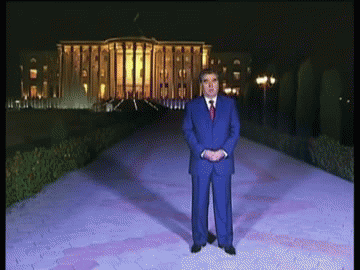
-
The Guardian has a feature on Spomeniks today: the strange and impressive WWII monuments that dot the former Yugoslavia. To read the article and see the images, click here. Photographer Jan Kempenaers has an exhibition featuring this work at UCLA this spring/summer; click here for information.
-
- May 29, 2013 - 12:49 am
- Russia
- Comments Off on Brezhnev Plaque Returns
RFE/RL
May 28, 2013
In Russia, Commemorative Plaque To Be Restored Amid Brezhnev Nostalgia
By Claire Bigg
Authorities have backed a plan to return a commemorative plaque to the Moscow apartment building where Soviet leader Leonid Brezhnev spent the last 30 years of his life.
A Moscow City Hall committee has approved the initiative, submitted by a group of State Duma deputies.
Supporters had hoped to have the plaque installed this month, but Aleksandr Khinshtein, a lawmaker with the ruling United Russia party and the driving force behind the project, said on Twitter that it will more likely be ready in December -- in time for Brezhnev's 107th birthday.
Khinshtein said on May 27 that the work had been commissioned to sculptor Aleksandr Rukavishnikov, the grandson of the artist who had produced the original plaque that once was affixed to the stately building at 26 Kutuzovsky Prospekt.
Brezhnev lived at this address from 1952 until his death in November 1982 at the age of 76.
The plaque was removed after the Soviet Union collapsed nine years later.
But critics say Brezhnev, whose 18-year rule was marked by political repression and economic stagnation, does not deserve the honor.
Memorial and other Russian rights group have been particularly vocal against the initiative.
"Our authorities are nostalgic about Soviet times, so they respond to the requests of citizens who feel the same nostalgia," Lyudmila Alekseyeva, the veteran rights activist and head of the Moscow Helsinki Group, tells RFE/RL. "In my opinion, looking back at the past is the last thing leaders and people should be doing. I don't miss those times, even though I'm an old person and I spent my youth during this period. I'm happy that we got rid of this unsuccessful Soviet experiment."
Although Brezhnev continues to be the butt of countless jokes, many Russians praise him for providing stability and presiding over Moscow's detente with the United States in the 1970s a thaw in relations that famously led to the first sales of Pepsi in the Soviet Union.
A spokesman for President Vladimir Putin, Dmitry Peskov, has called the Brezhnev era a "huge plus" for the country.
Last month, an opinion poll by the independent Levada Center found that 56 percent of Russians see Brezhnev as the greatest leader of the 20th century, followed by Vladimir Lenin and Josef Stalin.
-
- March 23, 2013 - 5:47 pm
- New monument, Poland
- Comments Off on Controversial Rainbow Sculpture in Warsaw
The New York Times reports on the controversy over a rainbow sculpture in central Warsaw seen as symbolic of gay and lesbian rights. See the link here for the full story and a top-notch photo of the half-burned sculpture.
March 21, 2013
Rainbow Becomes a Prism to View Gay Rights
By HANNA KOZLOWSKA
WARSAW — The 30-foot-tall rainbow sculpture in downtown Savior Square here is looking somewhat the worse for wear these days, half covered in patches of artificial flowers and half bare from being set on fire. What was intended as a work of public art without an overt political message beyond the need for inclusiveness, according to the artist behind it, has instead become part of a culture war over homosexuality that has been brewing in one of Europe’s most Catholic countries.
Since its June installation in the square — a busy crossing place for trams that also has a famous church and a buzzing bar and cafe scene — the rainbow has been set on fire four times and come under attack from right-wing politicians and Web sites.
Stanislaw Pieta, a member of Parliament from the conservative Law and Justice Party, the main opposition faction in Poland, called the placement of the rainbow on a grassy circle in front of the church a “disgusting gesture, offensive to Catholics.” He added, “It’s a provocation.”
Although city officials and the artist, Julita Wojcik, say the rainbow is not a monument to gay rights, both its supporters and opponents find they can agree on what the rainbow symbolizes.
The debate over gay rights has gathered steam in Europe over the past year. France’s lower house passed a bill last month that will grant the right to marry to same-sex couples if the upper house approves it in April, as expected. Germany’s Federal Constitutional Court last month expanded adoption rights for gay couples.
Poland’s first openly gay and transgender members of Parliament were elected in 2011. But their reception, even from the most prominent members of society, has been anything but a universal embrace. Lech Walesa, the former president, revered anti-Communist opposition leader and Nobel Peace Prize winner, surprised many here when he declared that gay lawmakers should be sitting in the back rows of the Polish Parliament, “or even behind a wall.”
Dorota Chojna, 39, a volunteer who has helped repair the burned rainbow, said in a telephone interview that she felt uneasy. “As a homosexual person, I don’t feel safe in Warsaw,” she said. “I became involved in the rebuilding to oppose pervasive homophobia, among other reasons.”
Poland’s economy has thrived in recent years, avoiding the deep recessions that have plagued its neighbors in Eastern Europe as well as the stagnation that has set in among countries to the west. But like many societies in the former Soviet bloc, Poland is divided between those who have benefited from the dynamic economy and those who feel left behind by rapid change, social as well as economic.
The rainbow was not the first work of public art to receive criticism here in Poland’s capital. While the city has long featured statues of kings, saints and the beloved composer Chopin, a 50-foot artificial palm tree by the artist Joanna Rajkowska caused confusion and no small amount of consternation when it was erected in 2002. A work about the city’s lost Jewish population — referring to the warmer climate in Israel — the palm tree has slowly been accepted as part of the city’s skyline.
“If the city is to develop, it needs new symbols,” said Ms. Rajkowska, who supports the rainbow.
Known as Plac Zbawiciela in Polish, Savior Square takes its name from the 19th-century Church of the Holiest Savior, whose twin spires tower over it. But the square is also known as Plac Hipstera, or hipster square. While older residents in overcoats and berets go to Mass at the church, minor celebrities and affluent teenagers sip lattes, all within sight of the damaged arch.
The structure was first installed in front of the European Parliament in Brussels in September 2011, to honor Poland’s turn at the rotating presidency of the European Union. Ms. Wojcik, its creator, said in an interview at the Zacheta National Gallery of Art in Warsaw that the rainbow was intended as a symbol of tolerance.
“In 2011, Poland was seen as a homophobic country,” she said. “I wanted to show that we’re not closed, but open-minded.”
Ms. Wojcik brought the rainbow back to Poland last June, in time for the European soccer championships that Poland hosted with neighboring Ukraine. Then the trouble began.
Originally covered with some 16,000 artificial flowers, the rainbow quickly turned into a giant Rorschach test for residents. To some, the rainbow is just a rainbow. “I think about the happiness in life,” said Jadwiga Wilczynska, 78, smiling as she looked at the sculpture.
To Wlodzimierz Paszynski, the deputy mayor of Warsaw, “It’s a sign of unity; it evokes warm feelings.”
Ms. Wojcik, 42, said: “The rainbow is not a pro- or anti-gay declaration. It’s about tolerance, diversity, openness.” She said her goal was to strip the rainbow of all its political meaning, leaving the interpretation open and making it a bridge of mutual tolerance. She apparently did not succeed in that goal, since the one reading of the sculpture has overshadowed any others.
At least one of the four fires has been deemed an accident from New Year’s fireworks. In another fire, the perpetrator was inebriated and, according to the Warsaw police, he did not disclose his motives. The other two fires remain unsolved.
Some insist that there is no larger goal behind the attacks. “It’s just vandalism,” said Maria Klosinska, whose sister owns Charlotte, a bistro on the square.
But the critic Roman Pawlowski wrote on the Polish online news site gazeta.pl that calling the arson “vandalism” was a euphemism. “Actually, we’re dealing with an act of terror,” he wrote.
The Rev. Dariusz Kowalczyk, a Jesuit priest, reminded readers of the Roman Catholic weekly Idziemy that rainbows have other connotations. “When we see a rainbow in the sky, we shouldn’t think about gay activists, but about Noah’s covenant with God,” he wrote.
The rainbow was meant to be a temporary fixture, but city authorities agreed to push back the date of its dismantling several times, and in February they decided to leave it there for another year. At night it becomes a jungle gym for adults, many of whom have been enjoying time in a nearby bar, who climb on top and even crawl inside the steel frame.
For a planned refurbishing, the Adam Mickiewicz Institute, a publicly financed organization that sponsored the rainbow, is looking for flame-resistant materials. But some feel that for a city scarred by war and Communism, the tattered, slightly charred version of the rainbow is fitting.
“It’s a testimony of sorts,” said Marcin Malenczyk, the owner of Karma Coffee, one of the cafes on the square. “It’s good that it’s had its adventures.”
Nicholas Kulish contributed reporting from Berlin.
-
From the Washington Post, embalmed leaders of the world. The story is below; go to http://www.washingtonpost.com/blogs/worldviews/wp/2013/03/08/a-photographic-guide-of-the-worlds-embalmed-leaders/?wprss=rss_world for a fascinating set of photos/videos as well.
A photographic guide to the world’s embalmed leaders
By Caitlin Dewey , Updated: March 8, 2013
When Hugo Chavez’s embalmed body is laid in a glass casket sometime next week, he will join at least eight other world leaders whose remains are on display for all eternity … or at least for as long as their keepers can preserve them.
Vice President Nicolas Maduro announced Thursday that Chavez’s body would be on permanent display at the Museum of the Revolution so that “his people will always have them.” While that idea may sound grotesque, it’s also not particularly novel.
The Russians, arguably the ones who perfected the practice, have put both Vladimir Lenin and Joseph Stalin on long-term display. Lenin’s body has been embalmed in a large tomb near the Kremlin since shortly after his death in 1924, preserved by a steady 61 degree temperature and a strict regimen of mild bleachings and soaks in glycerol and potassium acetate.
According to Time, Stalin’s embalmed body also laid near Lenin’s for about 10 years, but was hastily reburied under cover of darkness when the government tried to squash his cult of personality in the early ’60s.
The Russians seem to have inspired the North Koreans to similar displays. In 1994, a Russian team helped preserve the body of Kim Il-sung, North Korea’s founding president, the New York Times reports.
When Kim Jong Il died in late 2011, Russian scientists again went to Pyongyang to assist in the embalming; the late leader lies in a glass sarcophagus with filtered lights to keep his face looking rosy.
But Kim Jong Il and his father were by no means the first Asian leaders to get the Chavez treatment. The Vietnamese revolutionary Ho Chi Minh, who died in 1969, is displayed in a mausoleum in Hanoi modeled after Lenin’s. Since “Uncle Ho” died in the midst of the Vietnam War, his embalmers had to work in a cave in the North Vietnamese jungle, the New York Times reports.
One of the scientists who worked on him told the Times: “Not every expert is allowed to restore such treasured historical objects, like a Raphael or a Rembrandt. Those who do it, we tremble. I feel a great responsibility in my hands.” This video shows the changing of the guard outside Ho Chi Minh’s tomb.
Socialist leader Mao Zedong has lain in state in a mausoleum on Beijing’s Tiananmen Square since May 1977. According to Time, Soviet-Chinese tensions forced Mao’s embalmers to ask the Vietnamese, not the Russians, for advice — a plan that misfired slightly when the Vietnamese could not explain how to build an air-tight coffin.
The exiled Filipino dictator Ferdinand Marcos, who died in 1989, has lain embalmed in a public mausoleum in the northwest Philippines since the government allowed his body back into the country in 1993. His widow, Imelda Marcos, has battled the government for permission to bury him in the country’s presidential cemetery, the New York Times reports. She posted for photos kissing the crypt in 2010.
Chavez will be only the second Latin American leader to be preserved for all eternity. Embalmers emptied water from the cells of Eva Peron, the wife of Argentinian president Juan Peron, and replaced them with wax — an unusual technique that basically “turned her into a candle,” Egyptologist Bob Brier told the Post’s Monica Hesse in 2012. She’s now also missing a finger — when the junta overthrew Peron’s husband and took over their house, they cut one off to see if the body was fake.
Chavez’s body will, presumably, get better protection than that. AFP reports that Marcos’s embalmer has already offered up his services and is urging the Venezuelans to start the process before it gets “more difficult.”
“I will process anyone, anywhere,” he said, helpfully.
-
Slate reports on the removal of Heydar Aliyev's statue in Mexico City:
Last August, a statue of Heydar Aliyev, who ruled Azerbaijan from 1993 to 2003, was erected along Mexico City's grand Paseo de la Reforma, in a park renamed the “Mexico-Azerbaijan Friendship Park.” Around the same time, the Azerbaijani government built a second monument in a different park in memory of Azeri villagers killed by Armenian forces in 1992; the plaque in front of the statue refers to the massacre as a “genocide.” Azerbaijan had renovated both public spaces at a cost of about $5.4 million.
The inauguration of the Aliyev monument was attended by several top Mexican government officials, including the mayor. But the Mexican public, then engrossed in a presidential election campaign, paid little attention to a statue of a man who once led a country 8,000 miles away.
When the nouveau riche attempt to use their money to buy respect and prestige, it often backfires. Such was the case of the Azerbaijani government’s effort to honor its former president. Because once Mexico City residents became aware of the statue that had risen in their midst, they saw the effort for what it was: an authoritarian government clumsily trying to buy influence and whitewash the legacy of a dictator.
This past weekend it ended in humiliation for Azerbaijan, when city workers, guarded by 200 police in riot gear, loaded the monument onto a flatbed truck in the middle of the night and carted it away. “Now everybody talks about Azerbaijan, but in a bad way,” said Guillermo Osorno, a prominent journalist and member of a government commission appointed to study the monuments.
Read the full article here:
http://www.slate.com/articles/news_and_politics/foreigners/2013/01/heydar_aliyev_statue_mexico_city_told_azerbaijan_that_the_monument_to_the.single.html
See a video of the removal here: http://www.eluniversaltv.com.mx/detalle.php?d=34769
-

Ushangi Davitashvili kisses the bust of Soviet dictator Josef Stalin that stands in the courtyard of his apartment building in the Georgian capital, Tbilisi, Friday, Dec. 21, 2012. Photo: Shakh Aivazov / AP
By MISHA DZHINDZHIKHASHVILI, Associated Press
Updated 12:51 pm, Friday, December 21, 2012
TBILISI, Georgia (AP) — People across the vast territory where Josef Stalin once imposed his terror have marked the 133rd anniversary of the dictator's birth, some in hatred but others in reverence.
In Moscow, several hundred Russian Communists led by their leader Gennady Zuyganov laid flowers at Stalin's grave at the Red Square Friday, while smaller rallies were held across Russia and several former Soviet republics.
Leftists in neighboring Belarus said they found a Stalin statue that was buried after denunciation of his personality cult in 1956, but refused to specify its whereabouts because they fear authorities will order its destruction. Authorities in Stalin's hometown of Gori, Georgia, they will reinstall his statue that was removed in 2010.
In southern Ukraine, several ethnic Crimean Tatars trashed a small street exhibition on Stalin. The entire Crimean Tatar population of Ukraine was hastily deported in cattle trains on Stalin's orders in 1944 for their alleged collaboration with Nazi Germans during World War II. Of the 200,000 Crimean Tatars, almost a fifth died of starvation and diseases, and the survivors were allowed to return only in the late 1980s.
According to the prominent Russian right group Memorial, Stalin ordered the deaths of at least 724,000 people during the purges and repression of the 1930s, while millions died as a result of the forced labor system in Gulags, the Soviet prison system.
But, some people believe he was a strong and valiant leader whose grip on the nation was needed for security and his popularity in Russia has been climbing amid Kremlin-backed efforts to defend his image.
_____
Mansur Mirovalev contributed to this story from Moscow.
-

Pavlyuk Statue (RFE/RL Kyrgyz Service)
RFE/RL Kyrgyz Service
http://www.rferl.org/content/new-memorial-to-slain-journalist/24794220.html
December 10, 2012
BISHKEK -- A new monument to prominent Kyrgyz opposition journalist Gennady Pavlyuk has been unveiled in Bishkek.
The chief of the Kyrgyz presidential office, the Bishkek mayor, and Russian Embassy officials were present at the ceremony on December 10.
The first monument to the journalist was unveiled in October 2011, but it was stolen in May.
Pavlyuk, who was of Russian origin, died several days after being thrown from a building in Almaty in December 2009.
His arms and legs had been bound.
Pavlyuk's relatives and colleagues allege that the murder was politically motivated because he had joined the opposition movement against former President Kurmanbek Bakiev and his government.
A former Kyrgyz security service officer and two Kazakh citizens were found guilty of involvement into Pavlyuk’s murder and given prison sentences last year.
Copyright (c) 2012. RFE/RL, Inc. Reprinted with the permission of Radio Free Europe/Radio Liberty, 1201 Connecticut Ave., N.W. Washington DC 20036.












































 Vietnam's own statue of Lenin has pride of place in a park in central Hanoi
Vietnam's own statue of Lenin has pride of place in a park in central Hanoi




